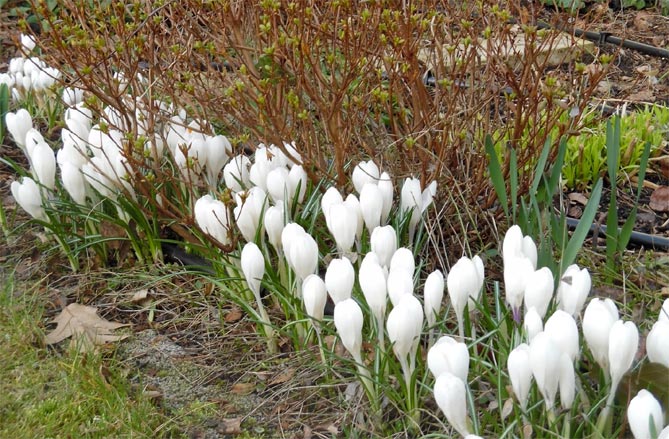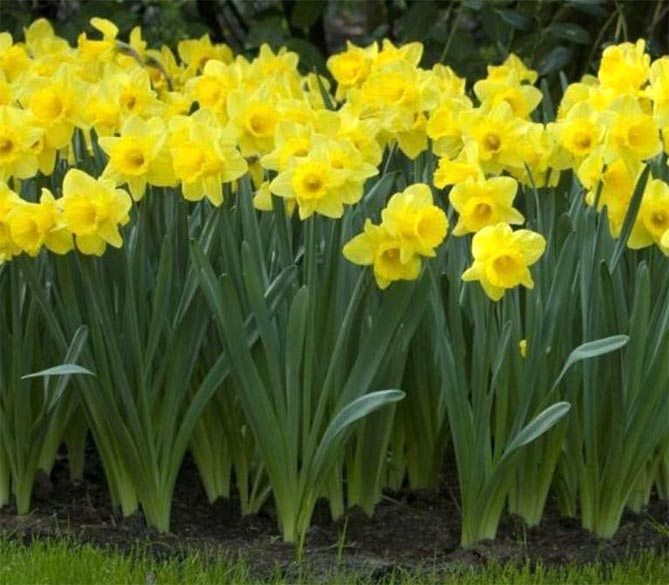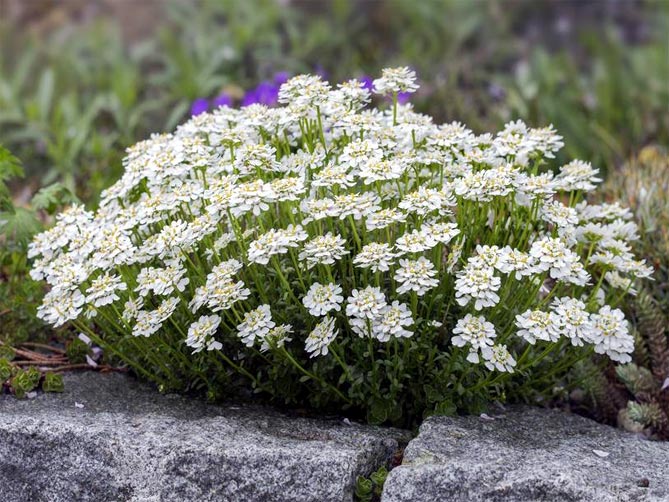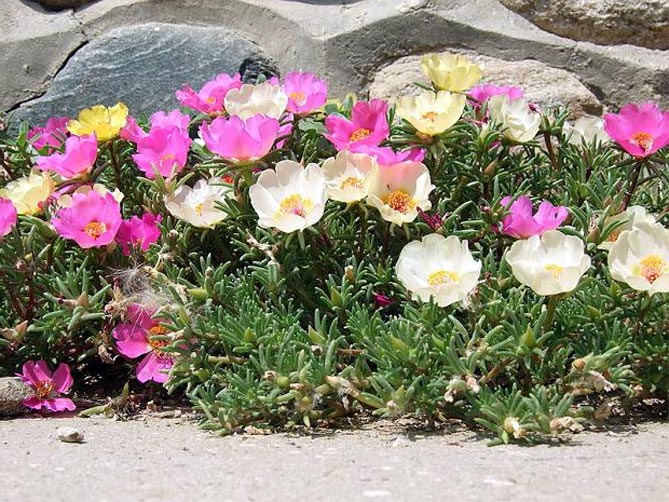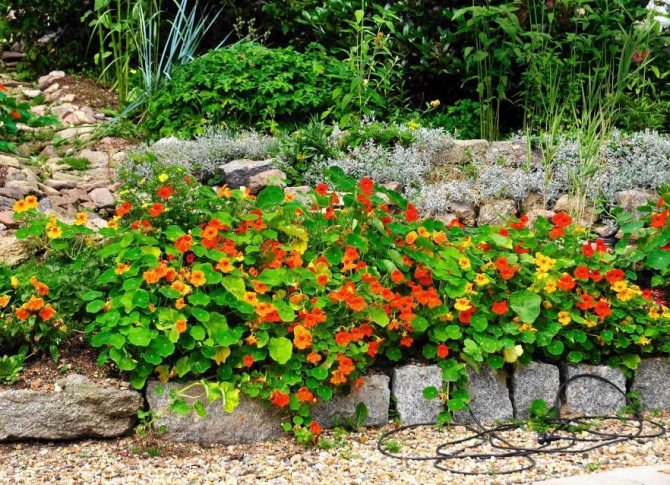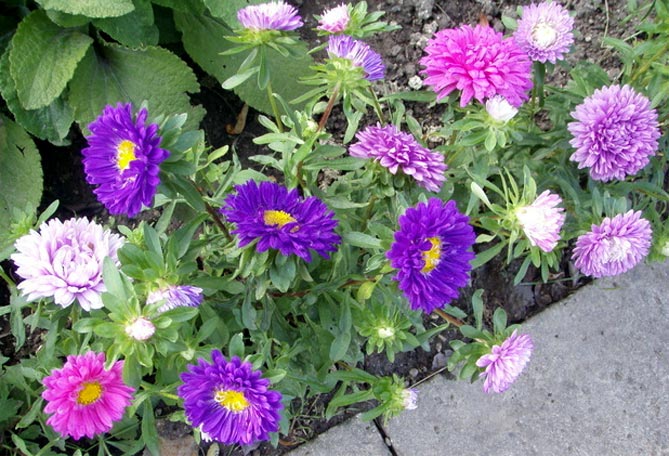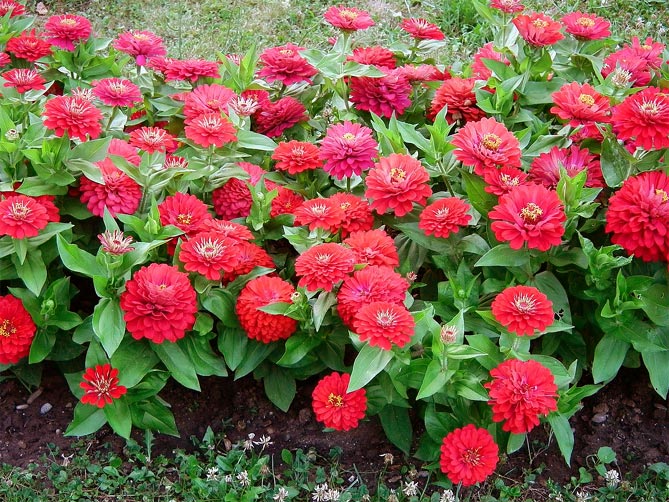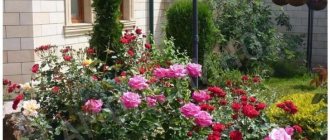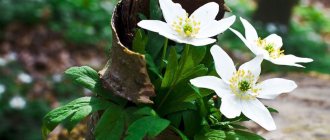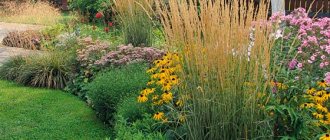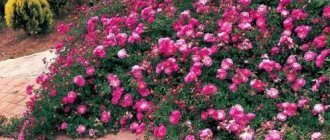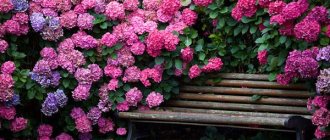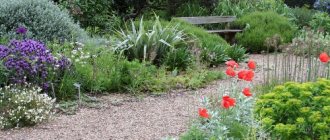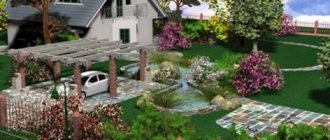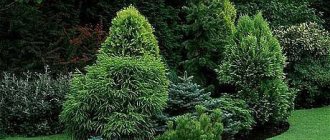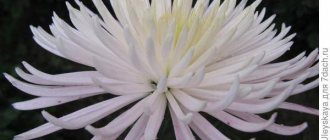It would seem that a luxurious flowerbed is ready, brand new paths have been laid in the garden, the lawn pleases the eye with bright greenery. But still, it seems that something is missing. A beautiful border of flowers will emphasize the sophistication of style and complete the picture of the garden. A low, narrow, densely planted strip of flowers, laid along the path or along the edge of a flower bed, lawn, alpine slide, and is a flower border. You can do it yourself. You just need to decide on its location and flowering time. This will determine which flowers are suitable for planting a border: perennial or annual, shade-loving or light-loving.
Perennial low-growing curb flowers - photo and name
Low-growing flowers for garden paths are chosen from a wide range of perennial plants.
This makes it possible to form flower borders and other decorative fences for flower beds for a longer period.
The root system of perennials hibernates without problems in the ground, and the vegetative part awakens every spring. A variety of low-growing species with different flowering periods, allows you to create unique compositions that do not fade until late autumn.
Dwarf shrubs
It is impossible not to mention dwarf shrubs. They are also suitable for edging curbs and forming hedges in a suburban area. Dwarf shrubs are divided into tall and low-growing. Today, conifers are very popular among gardeners. They look very impressive. Low shrubs and semi-shrubs are also chosen by a fairly large number of citizens. It's easy to look after them. It is recommended that you trim them periodically for a neat appearance. Shrubs and semi-shrubs grow lumber and are perennial plants.
When decorating the landscape, you can also use tall shrubs. For example, this will be a great solution for creating shadows. The shrub will cast a shadow and help to give originality to the overall picture of the garden.
Classification of curb plants
The landscape design of the site in front of the house implies the division of the territory into functional and decorative zones.
Between them, paths are usually laid, which are framed with living borders or allocated with rabat (flower beds in the form of a narrow strip).
For these purposes, use low-growing herbaceous and shrub perennial plants.
Depending on the height, perennials for borders are divided into creeping (ground cover), dwarf and undersized crops. The size of the dividing strip should not exceed 0.5 m in width and 40 cm in height.
In the design of garden paths, you can find mixborders, which are made up of several types: dwarf shrubs, herbaceous low-growing perennials and bulbous plants.
Perennial plants that are planted as curbs
In the home garden, as a rule, there are open and shaded areas. Therefore, when choosing border plants, their photophilousness should be taken into account.
Feels good in the shade of trees: astilbe, periwinkle, iris, galanthus, brunner, hellebore, etc.The sun's rays are useful for aquilegia, heuchera, veronica, daffodils, tulips, pinnate carnations, etc.
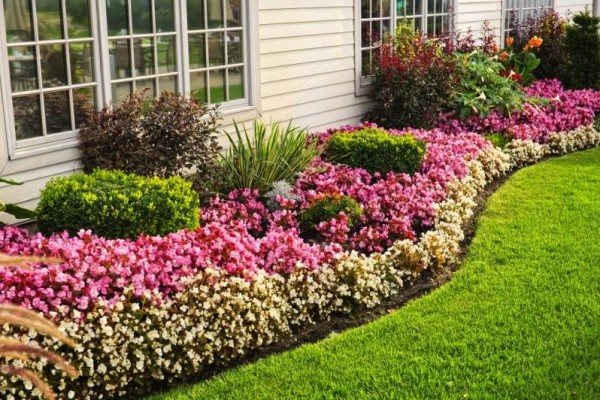
Bulbous plants
The bulbs are planted in autumn - from September to October. The remains of previous plantations are removed after digging and processing the soil. The bulbs are planted at the appropriate depth depending on the species. In the spring, when the plants are in full bloom at the same time, the effect will be impressive, which, unfortunately, comes at a significant cost. Labor costs for such plantings are also enormous. Bulbous curbs look best planted in one shape or color.
Examples of bulbous plants for curbs
| Name of herbs | Photo |
| crocuses (white and purple) |
|
| tulips | |
| daffodils |
|
Types of curb plants
Along the garden paths hMost often, perennial herbaceous plants are planted. Low-growing perennials do not require special care and do not need to be planted annually.
Resistance to low temperatures allows them to be used in areas with harsh winters. Some of the species take root well in the shade of trees and shrubs.
A perennial herb of a bush form - alpine aster grows up to 30 cm tall. Flowers are small with a yellow heart, narrow pink or blue petals. Grows in sunny and shaded areas. The flowering period is June – July. It grows well and does not require winter shelter. You can learn more about how to plant asters for seedlings from the next article.
Hosta is another type of perennial plant often used in the formation of a green border. Differs in wide lanceolate leaves of light and dark shades of green. Some varieties have variegated leaf color.
White, lilac or purple racemose inflorescences are located on tall smooth stems up to 30 cm high. Hosta blooms from July to August. Loves moist soil and shaded areas. Requires regular watering, preferably with a hose. The frost resistance of the species is at a high level.
Border chrysanthemum is a compact bushy plant 28–30 cm high. Chamomile-shaped flowers of various colors reach 8 cm in diameter. It begins to bloom in the middle of summer and ends with the first frost. To create a lush bush, it is necessary to pinch the shoots. It develops well in sunny areas and easily tolerates winter.
Miniature roses of the Debut variety grow up to 38 cm. Terry dark red flowers densely cover the dense bush. Blooming does not stop from June to September.
Roses are propagated by cuttings of vegetative shoots or seedlings, which are planted at a distance of 20-30 cm from each other. Young bushes for the winter are covered with spruce branches and a film frame.
Mature plants are most resistant to early frost and better adapted to sudden changes in temperature.
Getting to know a group of border perennials more closely
The greatest advantage of this type of plant is considered to be undemanding to care. When planted correctly, they don't need frequent watering and constant attention. The main concern should be given to the lighting requirements of the plants. Some like light and some like shade. By creating the best conditions for the plant, you provide long-term decoration on the site in advance. Curb perennials hide the unevenness of the soil better than other species and protect the rest of the plantings from the ubiquitous weeds. In addition to the requirements for illumination, they differ in the height of adult plants by:
- Stunted. Height does not exceed 30 cm.
- Medium-sized. The sizes of these species vary from 30 to 85 cm.
- Tall. Reach adult heights up to 180 cm.
In addition, there are curly and ground cover perennials.
All these species need to be planted in areas that are free of weeds.
Advice! To make the fence made of border perennials neat and even, they are placed in several rows (2-3) without large gaps between plants.
How can you combine border perennials? Fences from a mixture of various types look great. The only condition that must be met is the selection of plants with the same requirements for soil moisture, the amount of light, and coexistence with other "neighbors". It is good if these are unpretentious, weather-resistant species.
Attention! Border perennials are selected either in a single color scheme with plants in a flower bed, or in a contrasting one.
It depends on the preferences of the owner and compatibility with the rest of the decor elements. Some deviation from the generally accepted rules will add originality. You can simultaneously decorate the border with perennials of different heights and different shades.
Low-growing perennials are well suited for decorating a border along garden paths, along the edges of flower beds and rabatki.
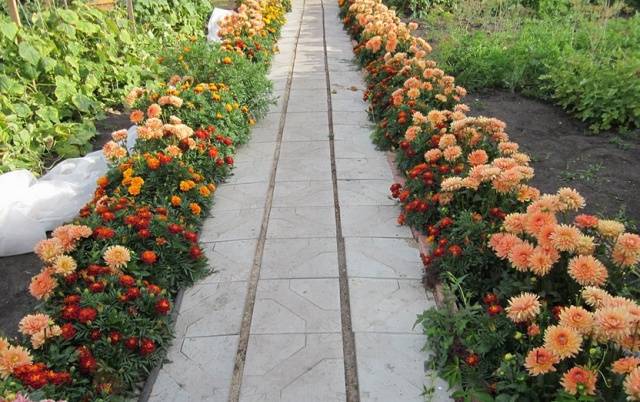

Medium-sized ones participate in tiered compositions, are used for planting as a separate element in vegetable fences.
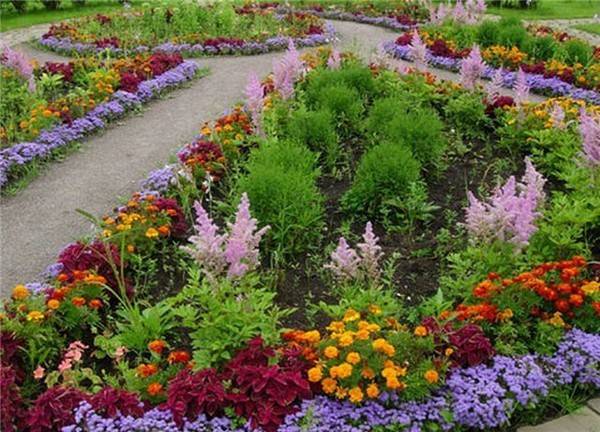

Tall perennials will come in handy when decorating a front garden with a border, for dividing the site into zones. Suitable for planting in the center of tiered compositions.
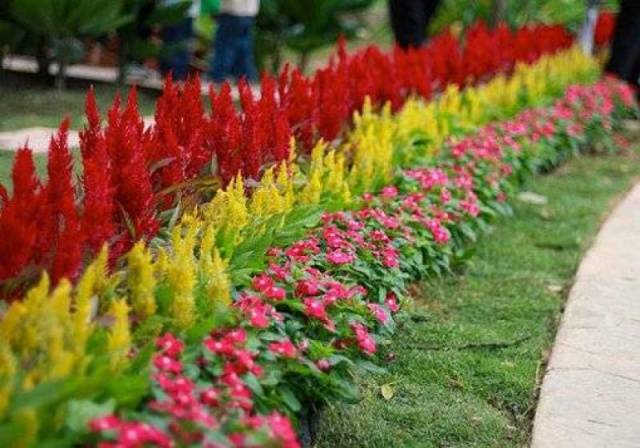

Curly are used to decorate the perimeter of garden pavilions, terraces, and residential buildings. Curly perennials look great on barrage structures, giving them a neat and attractive look.
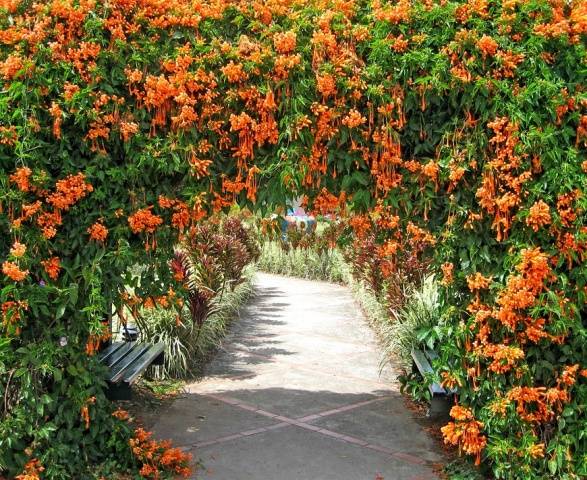

Ground cover border perennials:
- they cope wonderfully with weeds;
- protect the fertile soil layer from being washed away by rains or blown away by winds;
- improve soil fertility;
- play the role of natural mulch;
- hide surface defects well;
- bloom throughout the season;
- grow quickly, creating a bright rug in the desired area.
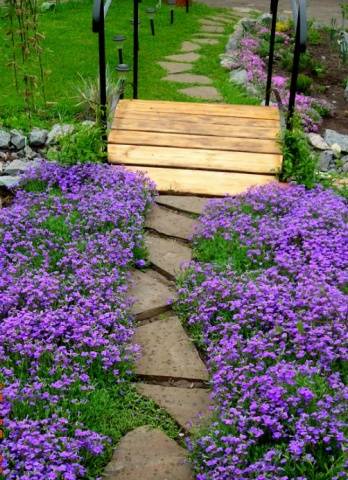

For border perennials, fertilizing will be required taking into account the needs of each plant, careful loosening of the soil, regular removal of sick and dried individuals.
Rules for creating flower borders
A flowering border, which will delight the eye throughout the summer season, is formed from several types of plants. Small-bulbous and bulbous perennials are the first to bloom in the spring.
They are planted closer to the edge of the path, followed by a strip of herbaceous plants that bloom in summer. Low-growing crops that will bloom in autumn are placed along the outer perimeter of the border.
Now in more detail:
When decorating a border, plants should be selected according to the color scheme. It can be sustained in shades of the same color or in contrasting combinations. So that the harmonious lines of the drawing are not interrupted, the plants are planted tightly to each other.
Combination of perennials
How can you combine border perennials? The most popular varieties:
Solid color border
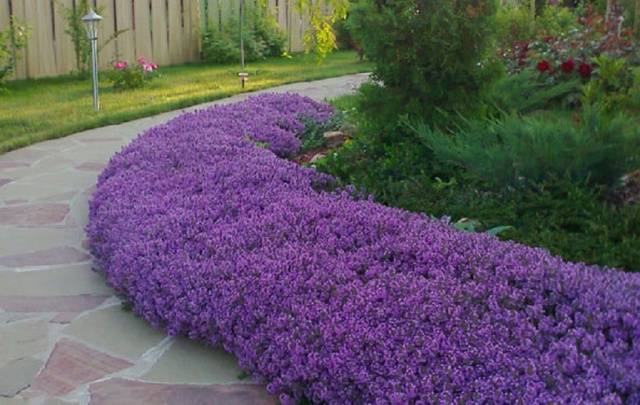

Plants of the same color, but different or the same height, will do. This is at the request of the owner of the site. The tone can be harmonious or contrasting with the rest of the plants.
Variegated border
It is very easy to make a striped fence or pick up border perennials that match in color.
Caring for perennial plants in the border composition
Perennial ornamental crops need proper care:
- Regular watering;
- Periodic feeding;
- Treatment for diseases and pests. For example, spraying plants with Bordeaux mixture;
- Loosening and mulching of the soil;
- Timely pruning of shrubs;
- Shelter of young plants for the winter.
The main problem of perennials in a confined space is their constant growth and reproduction. To make the border look the same every year, it is necessary to plant overgrown flowers in a timely manner, dig up bulbs and cut shrubs.
The orderly beauty of border compositions and roadside ridges depends on proper planning and thoughtful selection of ornamental plants. Symmetry, color harmony and well-groomed borders emphasize the beauty of the garden and create a unique framing for every part of it. From this video you will find out which low-growing plant varieties are used by landscape designers to create living borders:
What flowers to choose for a flower bed
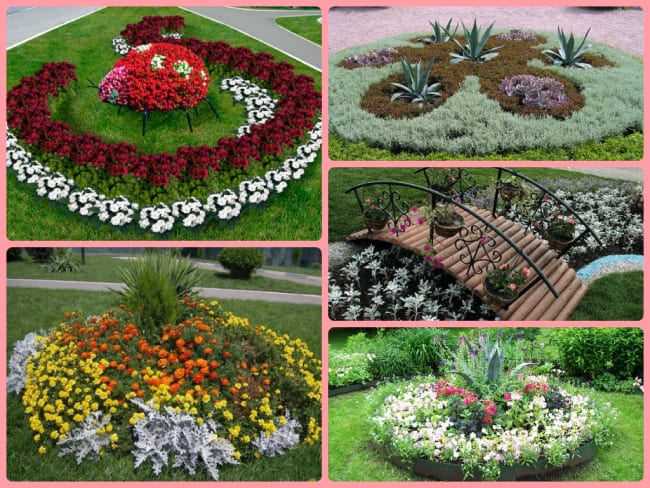

Beautiful flower beds
The next step after choosing the type of flower bed is the selection of flowers for the growing season. The main advantages of the summer workers:
- bright lush bloom;
- the ability to change the appearance of the flower garden every season;
- unpretentious care;
- many kinds of varieties.
The advantages of perennials are frost resistance, easy care, simple reproduction (mainly by dividing the bush), which allows you to save on the annual purchase of seeds. They still need to be updated every 7 years. Instead, you can choose new varieties, change the composition or color scheme.
Both types of undersized flowers can be combined with each other. To do this, you need to adhere to the following recommendations:
- If the flower garden is small, do not plant too densely. Perennials need room to grow.
- Look for flowers with similar growing conditions. Light-loving - for flower beds in the sun, shade-loving - for flower beds in the shade, partial shade. Consider moisture, soil characteristics, maintenance requirements.
- For mixed compositions, select plants by height and plant them depending on the location of the flower bed. If it is visible from one side, place low grades in front, higher ones behind them. If the flower garden can be walked around from all sides, plant taller flowers in the center and the lowest ones at the edges.
- To create continuous flowering compositions, select plants with different flowering periods and adhere to planting dates. Plant bulbs in the fall, and marigolds and similar flowers in the spring.
Low-growing curb plants: names and photos
Curb plants are low-growing crops used to frame paths and sidewalks, planted along the very edge of a flower bed or flower garden. On this page they are presented with titles and descriptions. You can see photos of the most beautiful undersized border plants.
Most often, in order to create a beautiful garden and the design of your site, not only tapeworm and group plantings are required, but also low-growing border plants, which play an important role in solving this issue. There are many names for perennial and annual flowers that are used for edging flower beds, paths and even more bulky compositions of different types. In this issue, we will learn about the most popular plants used by gardeners as border crops and see their photos.
Read also: Best tips for the care and planting of red mountain ash
As a border plant, types of flowers are most often used that contrast with the main plantings, shading them. All species are divided into several groups, namely, undersized (10-25 cm in height), medium-sized (30-60 cm) and large (up to 1 meter in height).
Perennials - a worthy setting for any flower bed
Plants are called curb perennial flowers that allow their upper herbaceous part to die with the onset of cold weather, while their rhizomes simply fall asleep for the time being. In spring, it is time to awaken and new shoots grow from the roots so that flowering does not stop for many years.
Chives bow. Otherwise, this plant is called speed. It is a bulbous plant that multiplies very quickly. You can plant only one onion in the spring, and by the fall a valuable bunch of onions will grow from it.
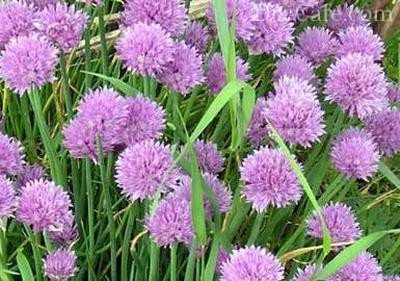

Sunshine, lime-rich soils and moderate watering are the main priorities of this plant, chives can be used for food
Arabis. This melliferous plant can produce flowers in white, pink, red, purple or pink. It all depends on its grade. Small flowers can even be double.
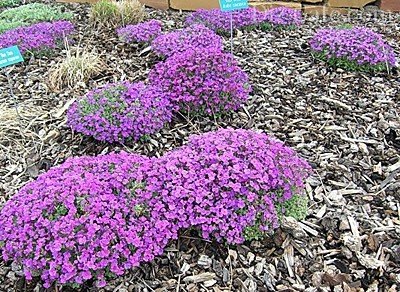

Collected in a brush, arabis flowers appear in April and remain in excellent condition for up to 8 weeks, arabis can grow significantly
Avens. The plant reproduces well both by seeds and vegetatively. The large flowers are rich in nectar, very decorative and attractive. Gravilat seeds planted in the soil can hatch by autumn, but usually mass germination occurs only next spring. Gravilat is also valued as a medicinal plant, but is also beautiful as a border flower. Gravilat forms rosettes for the new year of flowering right under the cover of snow.
Gravilat is also valued as a medicinal plant, but it is also beautiful and simply as a border flower, it forms rosettes for the new year of flowering right under the cover of snow
Sedum. These light-loving plants can only tolerate minor shade. Bright and juicy stonecrops in the shade become completely different from themselves. They are even capable of losing their shape. But the sun can give this plant a real tan or a special blush. However, stonecrop, for example, cannot stand the direct sun and puts up with the shade. Stonecrops can grow in one place for about five years.
Tenacious. This variety of evergreen curb stunted perennial flowers covers the ground with a solid carpet. Differs in endurance and unpretentiousness. The leaves of the tenacious are dark green and even purple. Shade may vary depending on weather conditions and time of year.
The tenacious bloom with blue flowers at the same time as iris and Japanese spirea, this plant is often used not only for borders, but also for rocky hills
Read also: How to plant a tree correctly: planting a tree and caring for it, preparing seedlings, choosing the timing and stages of work
Feverfew. This plant is notable for its numerous flowers that are very similar to chamomile. It is better to propagate feverfew by seeds. They are sown in a greenhouse in March.
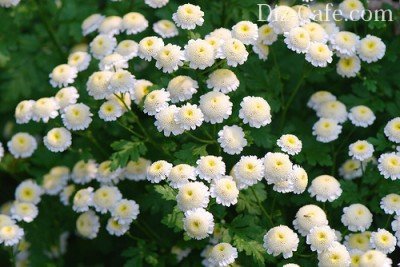

The plant must undergo pickering, and in June the seedlings are already planted in open ground. The golden color of the leaves of pyrethrum will persist only if the plantings are placed on the sunny side
If anyone thought that this list represented at least a third of all the plants that are used for borders, he was mistaken. Curb plants are remarkable precisely because their list is inexhaustible. It is possible to create amazing tapes from them, as Gertrude Jekyll once did, forming the play of colors and the play of shades under the influence of impressionist artists.
Annual border plants (with photo)
Annual plants, which have very large advantages, are very popular as a border planting. The first thing I would like to say is that such flowers require annual renewal, therefore, with the help of them, very beautiful forms can be created. Unlike perennial varieties and hybrids, this form does not have time to get bored.
Next year, if you want, you can plant the same plant again, without having to get rid of the old planting. But, it is worth noting here that some flowers, when propagated by seeds, can differ significantly from the uterine flower. For example, the inflorescence may be of a different shade or the bush will grow a little more.
The second reason why they often choose not perennial, but annual border plants is that they have a longer growing season, in other words, they bloom longer.There are just a huge number of names of varieties and hybrids that gardeners grow, let's talk about the most beautiful and original of them.
The first most popular annual plant, acting as a border flower, is the miniature or Chinese aster. It appeared in culture a long time ago and has a large number of names used to decorate flower beds, paths and rockeries. This undersized border plant is represented by many interesting varieties that differ from each other not only in color, but also in the diameter of beautiful inflorescences.
So, for example, the most popular border aster Crimson can reach 25-30 cm.Its bush grows 30 cm wide, and densely double flowers are about 5-7 cm in diameter.Astra Crimson is considered a classic border plant, but other low-growing varieties are also used for this purpose. One of these is called "Milady", reaches 10 cm in height and 25 in width, forming a sprawling bush with bright flowers that can be observed from July to early autumn.
Look at the annual border plants in the photo, which illustrates their decorative qualities:
Zinnia is also a rather beautiful annual plant, but unlike the same marigolds, you can use different types to decorate various flower beds and other designs. ... The fact is that in landscape design, both medium and miniature species are equally used. Most often, as a border plant, you can see such hybrids as "midget", up to 30 cm tall with dense double flowers blooming all summer, and "Chip and Dale", up to 40 cm high.
A very light-loving plant that does not tolerate even partial shading is Nasturtium, which is considered a rather difficult annual to grow. But, even in spite of this, it is often used for edging various flower plantings in the garden. The heat-loving nasturtium, grown in peat pots, often blooms with beautiful orange and red buds, as can be seen in the photo below.
Like white ash corals, the Cineraria curb is formed. This exotic annual plays a large role in garden decoration. Its main decorative part is the leaves and stems of ashy color, which, when shaded, the plants acquire a mysterious silvery hue. Cineraria grows from the end of May to frost, after which it dies.
Assigning Border Colors
In the garden, it is often necessary to emphasize the correct or fancy shape of a flower bed, rabatka, or surround a tree on a lawn. For outlines and borders in the garden, low plants are usually chosen that will not hide the greenery planted in the depths or the permanent architectural elements of the garden. They should be compact and thicken well - then the borders look the most effective and create geometric (or irregular) patterns.
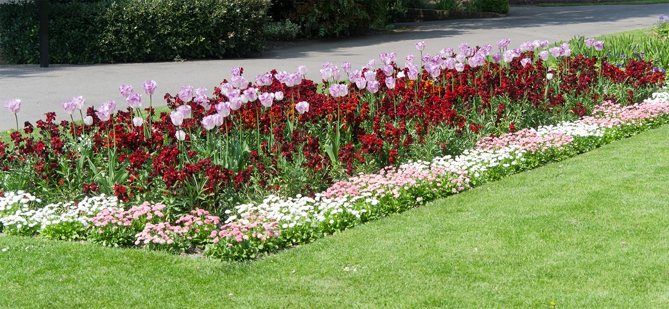

The list of curb garden flowers suitable for use in our climate is very long - so it is easy to match greens to a particular style of garden. The most commonly used:
- undersized annuals;
- ground cover biennial plants;
- perennials;
- shrubs.
Attention! In places where children are often, it is better to plant greens that are resistant to trampling and mechanical damage. Such sensitive border areas are often found along paths, lawns, and playgrounds.
Plants are planted for strokes in various places:
- on the outskirts of flower beds;
- along rows of other colors;
- along the tracks;
- along the curbs;
- wherever you need to mark a line.
It is best to choose flowers with a long flowering period.
You can also read: stunted flowers blooming all summer.
Such plants are used mainly for garden beds, planting in balcony boxes, containers.
In the world of annuals, biennials, perennials and shrubs, there are many options available for forming decorative green or flowering borders. When choosing an option for a garden, you need to remember the basic rule - the borders must be dense so that they immediately give the desired effect. Plants are planted side by side so as not to wait for the compaction of the planting, because the idea of the border lies precisely in this uniform form, without tears and wilted samples. The curb must be visible from a distance.
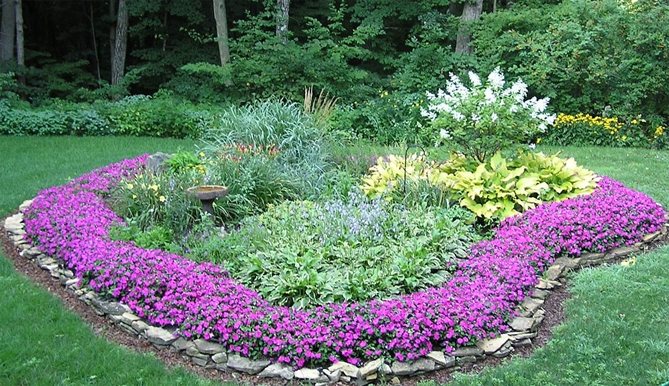

When choosing plants for mini hedges, position, soil type and soil response should be considered. It is also important in which area flowering borders are planted - so that the garden merges and harmonizes with the environment.
Perennial crops of border plants: names and photos
Among the perennial low-growing plants for decorating borders, you can find many names for interesting flowers. One of the varieties is the light-loving Arabis, which blooms with beautiful red, pink and white buds, which gardeners observe from April to July. It is best to grow a plant in a sunny area, since it does not like shading - from it the flowering is less saturated.
In the period from April to the end of June, primroses also bloom, which reach 10-30 cm in height. The flowers of the perennial are pink, yellow, dark red or white. Primrose is a fairly popular low-growing border plant, you can see it in the photo below.
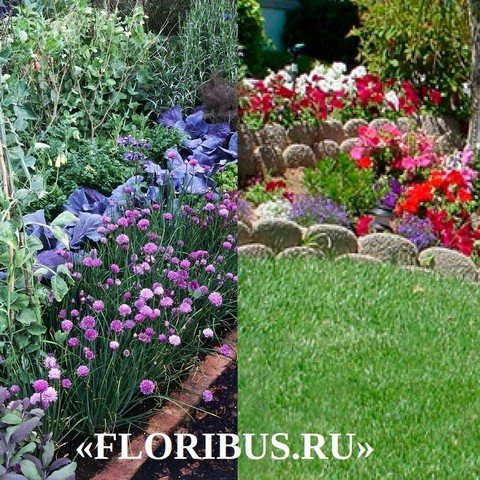

Edelweiss or leontopodium is a great plant for those looking to grow a curb plant for edging rock gardens or stone fences. It reaches 12-25 cm in height and blooms with white star-like buds.
The funny chives are also among the perennial low-growing border plants. This bulbous flower is quite fast growing. By planting one bulb in the ground, you can get a large number of new plants on the site by mid-summer. The flowers of chives are a bit like clover, but their petals are longer and the shade is richer. Terry buds are usually purple in color. Flowering can be observed from July to mid-autumn.
By the way, low-growing plants are not always used as a border plant, as for perennials, these can be crops of medium height, that is, from 30 to 60 cm.Among such decorative hybrids is the dicenter, it reaches 30 cm or 1 meter, depending on varieties. The flowers of this plant resemble a heart split in two, flowering can be observed in the middle of summer, it lasts no more than 2 months.
Graphilate is another beautiful curb plant, ranging in height from 30 to 60 cm. He has bright red flowers that can be yellow. Gravilat is distinguished by large buds, which can be seen from May to June or in our photo.
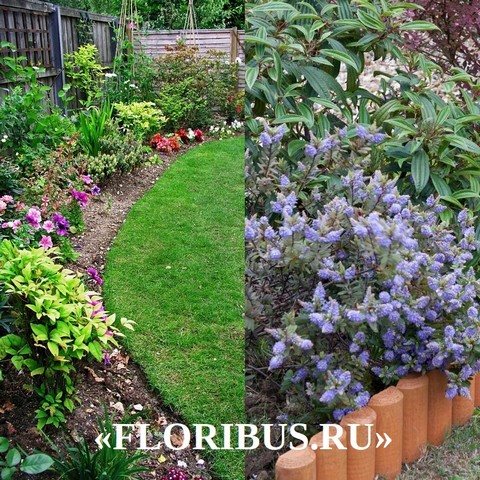

Read also: Nigella Damascus: description, planting and care, photo
Low-growing annual and biennial flowers
Consider the best and most popular plants with a short lifespan - 1-2 years.
Annuals
Annuals are more troublesome than perennials, but include many beautiful species that can be swapped every year.
Benefits:
- low purchase cost - in the case when there are a lot of borders - this is important;
- colorful flower beds;
- long flowering, up to frost;
- sowing new annuals each year makes the garden different in each season.
The disadvantage of annuals is the high labor intensity of sowing, picking, planting.
A convenient choice is seeds that can be sown directly into the ground - Marigolds, Sea Lobularia, Marigolds. This will make the care work easier, because growing seedlings, picking and then replanting to permanent places takes a lot of time.
Seedlings from seedlings can be grown independently.The first sowing begins in January and requires compliance with growing conditions. You can purchase ready-made seedlings. Of course, your own product will cost less, but you need to be patient and tune in to additional work.
Examples of annuals
| Name | Photo |
| Burachok or allisum (Lobularia) |
|
| Purslane (Portulaca) |
|
| Dwarf nasturtium (Tropaeolum) |
|
| Callistephus Chinese or Aster (Callistephus) |
|
| Zinnia |
|
The most commonly used annuals that bloom long until the very frost:
- brilliant sage;
- evergreen begonia;
- Hawker's balsam;
- lobelia;
- ageratum;
- brachycoma Iberisoliferous;
- ashy groundwort.
Biennial plants
Self-cultivation of two-year-olds takes a long time:
- In the first year, in May-June, seeds are sown and seedlings are hardened in pots or soil.
- In the second year, they are planted in a permanent place.
Examples of biennials for curbs:
- chamomile;
- pansies;
- heirantus (lacfiol);
- forget-me-not.
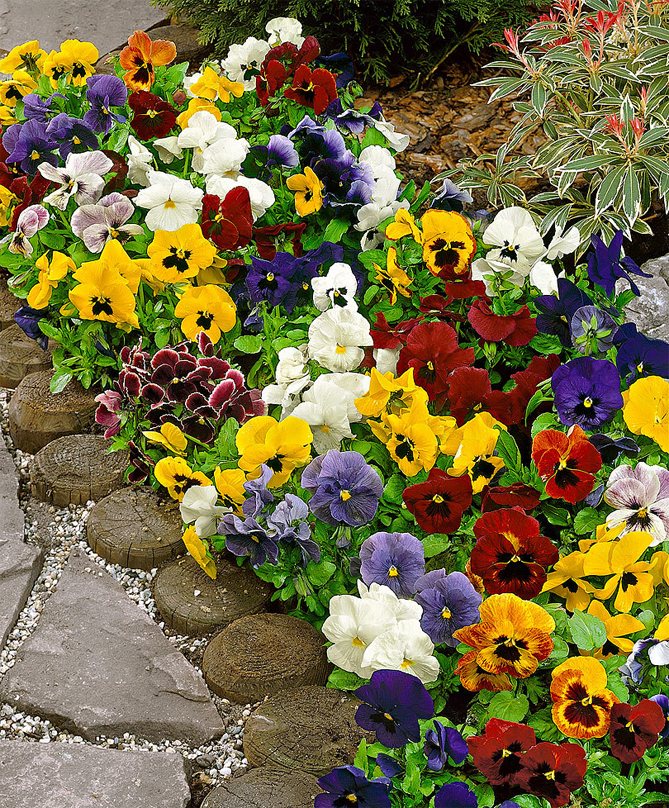

Marigolds (black shaves)
These popular flowers are prized for their ease of growing and long and abundant flowering. Marigolds begin to bloom in June and bloom until October in a palette of colors: yellow, orange, red. For borders, it is worth choosing species and varieties with low stature, not exceeding 30 cm in height.
The bitter and intense aroma of marigold is not for everyone. These flowers are beautiful, bloom for a long time, so they can be planted away from home, for example, under a fence, on the outskirts of a rabatka.
Begonia Semperflorence (ever-flowering)
Beautiful border flowers - begonia (Begonia semperflorens). This annual usually grows up to 50 cm in height, it can be kept lower if you choose low varieties. Begonia blooms from June to October. The color of the flowers is white, yellow, salmon, orange, red. This species is very easy to grow and looks beautiful along the borders and perimeter.
Pansies
It is called the violet Vittrock, viola or pansies (Viola vittrockiana). The popular plant is successfully used for borders and strokes with one caveat: you need to plant one variety of these border flowers of the same color. Viola is easy to grow, it will withstand accidental trampling, it blooms for a long time (March - October).
Ornamental cabbage
It is a crop with an unusual look. Ornamental cabbage (Brassica oleracea) is a biennial plant with a height of 30 cm. The pride of culture is a rosette of multi-colored leaves. An ornamental crop adorns the garden in fall and early winter and tolerates trampling. The color of the leaves is very diverse: red, purple, purple, white-cream, yellow. Ornamental cabbage is an ideal plant for low flower beds and curbs. Looks great in compositions with other annuals and perennials.
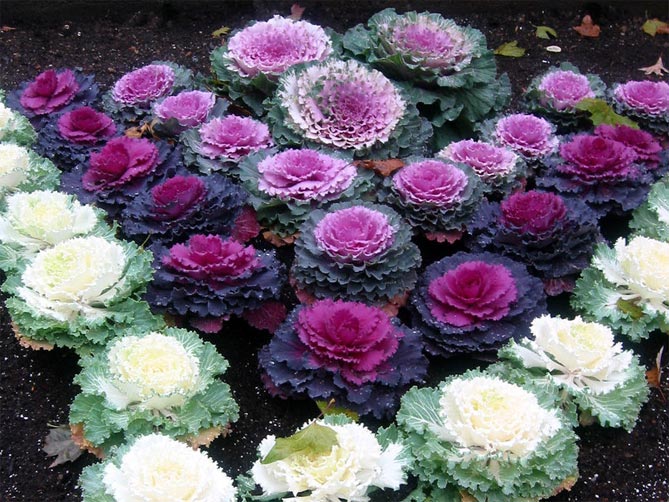

Touchy
Balsam or touch-me-not (Impatiens) - curb annual. Dwarf annual low-growing varieties of balsam grow up to 15 cm. Flowers are simple and double in a wide range of colors (even two-color). A touch-me-not, planted on curbs, can bloom from May to September. This is a good suggestion for decorating lawn edges and borders in partially shaded areas.
Sage brilliant
Ornamental sage brilliant or brilliant salvia (Salvia splendens) grows to a height of 20-40 cm, loves sunny places. The most popular is red sage, but varieties with white, salmon or purple flowers can be grown. Blooms from June to September. Sage is indispensable in large flower beds and as a curb plant.
Long-flowered
Ageratum Gauston or long-flowered (Ageratum houstanianum) - an annual grows up to 20-30 cm in height. It blooms in purple or white from June to October. The long-flowered plant compresses well, therefore it is readily planted as a curb plant.
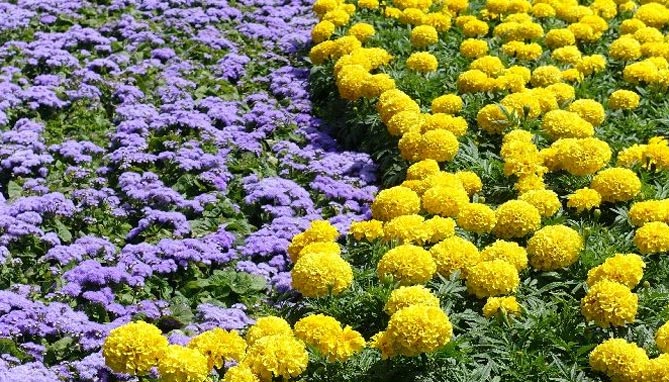

Daisy
Decorative daisy flowers (Bellis perennis) - biennial plants reach a height of 4-20 cm. They create rosettes from scapular leaves. The inflorescence baskets are white-yellow or pinkish. The daisy blooms from March to July. These flowers are often grown in gardens.
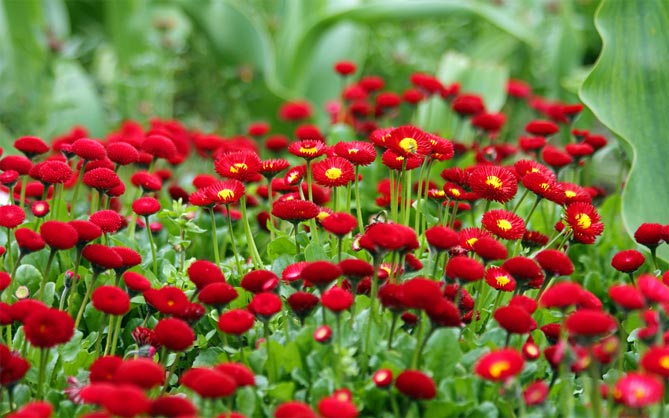

Curb flowers perennial undersized
No matter how beautiful the picture is, it will not look without a decent frame. So it is with flower beds. Only a flower bed that has neat borders can look harmonious.For their formation, stunted perennial flowers are most often used. With the help of them, a laconic frame is assembled.
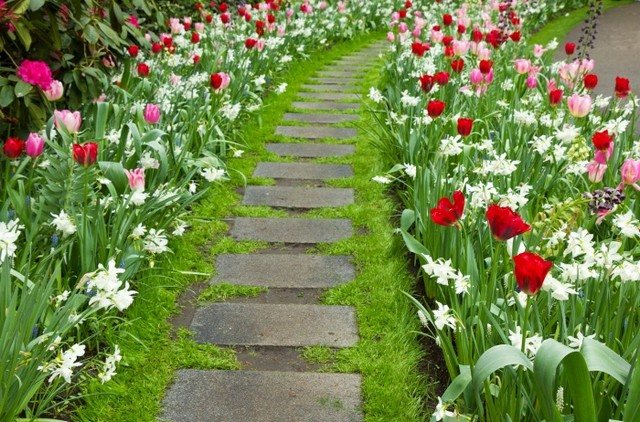

They are used to decorate garden paths, a harmonious figure of the general layout is written on the site. The use of natural flowers instead of brick strips or wooden fences is impressive. Therefore, the story about what long blooming compositions can be collected on your own site continues to be relevant.
Undersized shrubs for the curb
Perennial ornamental deciduous shrubs suitable for creating curb hedges include:
- undersized barberry;
- rhododendron;
- boxwood;
- cotoneaster;
- honeysuckle;
- Karagan;
- Fortune's euonymus.
The choice of unpretentious plants will be diversified by dyeing gorse, cinquefoil, mahonia, almonds, currants and gooseberries, snowberries, spiraea, chaenomeles.
Annuals will live a short but vibrant life. Crops are inexpensive and bloom beautifully. The edging is renewed annually to create fresh compositions of beautiful plants. Below is a small list of the best varieties:
- marigolds with double and simple flowers;
- sun-loving nasturtium;
- drought-resistant verbena;
- ageratum with amazing blue color;
- ground cover iberis;
- silvery cineraria;
- lush argiranthemum (proper cultivation and care at home allows the annual to reach the size of a shrub).
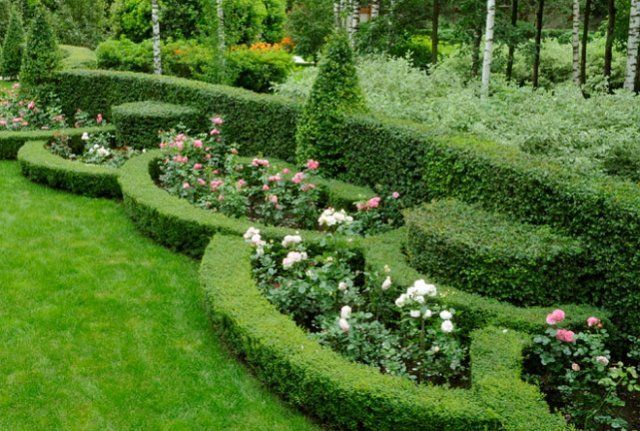

Decorative border from undersized bushes
The overall impression of the work of art depends on how the frame matches the picture. Border flowers create a kind of frame, bordering flower beds, paths, beds in gardens with a geometric layout. However, in natural-style gardens, curbs are not used at all. Bricks, tapes or fences can be used as fencing. It's a matter of taste. The use of fresh flowers where appropriate is always impressive.
Rules for creating border compositions
There are clearly formulated principles for creating curbs, the floral edging was first created in his own garden by the English landscape designer Gertrude Jekyll. Until now, her work is considered an example of high taste. She advises all beginners, before trying to experiment and choosing low perennial flowers for planting, learn their names and look through photos of finished works. This will help you understand how and where to move, in which direction.
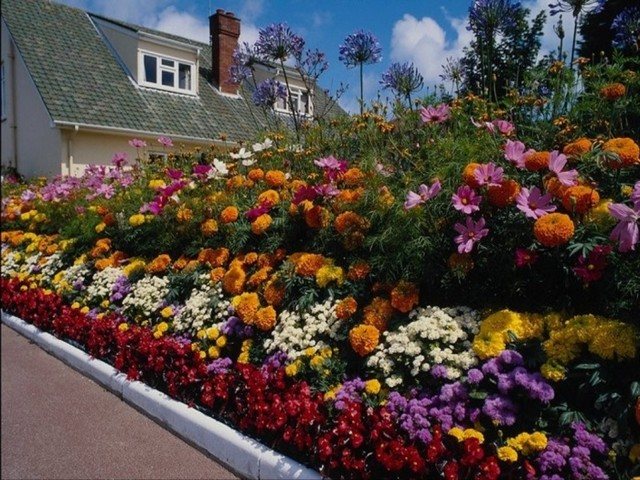

To make the overall picture harmonious, it is important to achieve the following effects:
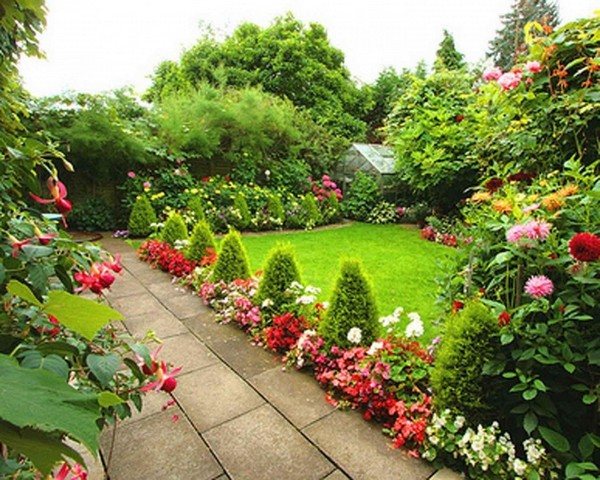

Therefore, it is best to acquire unpretentious flowers that can demonstrate endurance in conditions of limited growth.
Given all this, it becomes clear that the end result will largely depend on the correct choice of varieties of perennial undersized flowers.
Tips from landscape designers
Landscaping specialist Gertrude Jekyll deduced the basic principles of border shaping from flowers. Famous gardeners and designers have been using her advice for many years. Why don't we turn to them before we arrange an exquisite border with our own hands?
In order for the original flower edging to perform its functions and have an attractive appearance, certain rules must be followed when creating it:
- Borders should contrast with their color scheme with a flower bed, path or lawn, otherwise a beautiful edging will simply not work.
- For perennial low-growing flowers, a little more space will be required, taking into account their growth.
- Plants of the same species are best planted in two rows to avoid empty spaces in the edging.
- The classic sizes of flower borders are: width - 50 cm, height - 40 cm. When creating your own picture of a garden, it is not necessary to strictly adhere to these parameters. If the curb is needed to delineate the boundaries of a lawn with tall shrubs, then the plants for the curb may be taller.In addition, some flowers, both perennial and annual, lend themselves well to haircuts.
- For borders, it is better to choose slow-growing, low flowers. They will decay less, and the floral edging will always look neat and well-groomed.
- So that plants do not lose their decorative effect under any weather conditions, they must be chosen according to the following principles: unpretentiousness, drought and frost resistance, endurance even in limited growth conditions.
To create a high-quality border with your own hands, it is important to choose the right plants for it.
Noteworthy perennials
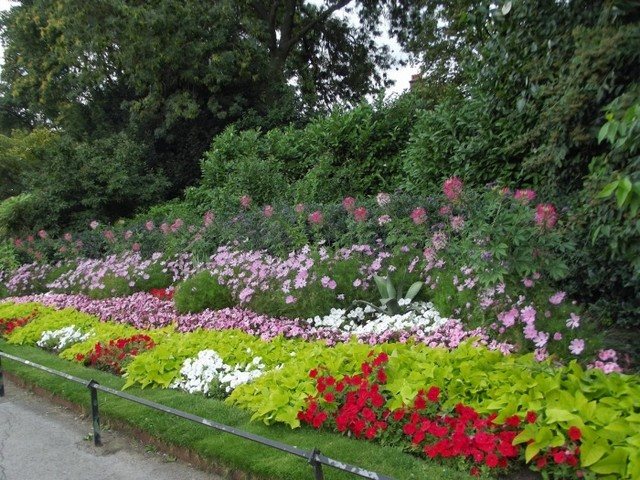

What are perennial low-growing flowers? These are plants, the herbaceous part of which dies with the onset of the first cold weather, and the root system falls asleep for the winter. In the spring, with the onset of warm days, she wakes up and gives new green shoots.
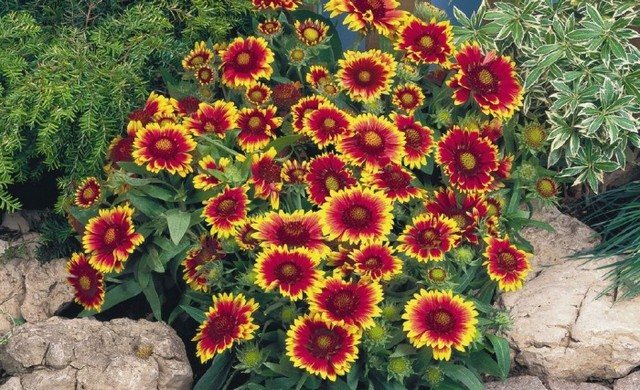

Such a cycle lasts a long time, so once the planted flower border will delight the eyes of the owners of the site for a long time. What plants have similar properties? Let's list those that are most common in our country.
A fry or chives multiply quite quickly, so experienced gardeners advise planting only one bulb in the spring, and a whole bunch of it will appear in the fall. This plant needs bright sun, lime-rich soils and moderate watering for normal growth. Purple buds and sharp leaves form a fairly dense planting.
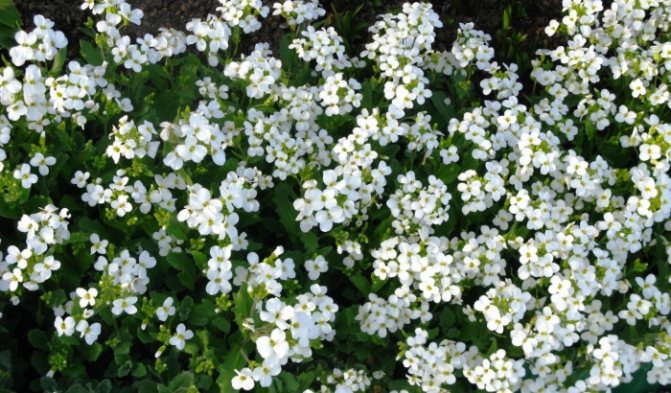

A honey plant called arabis is represented by different varieties, so it is important to be interested in what shade the flowers will be before planting. White, pink, purple and even red - small inflorescences form a terry cover that looks quite impressive. Plants grow rapidly, therefore, when forming curbs, you will have to constantly monitor the shape of the framing. Flowers appear in April and are pleasing to the eye for eight weeks.
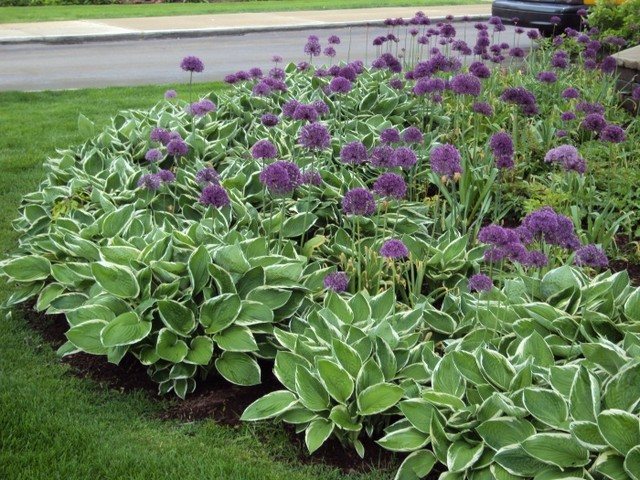

Bright and juicy in color cleaning - sun-loving perennial flowers. They quickly lose their attractiveness in the shade, but in open areas they demonstrate their blooming splendor.
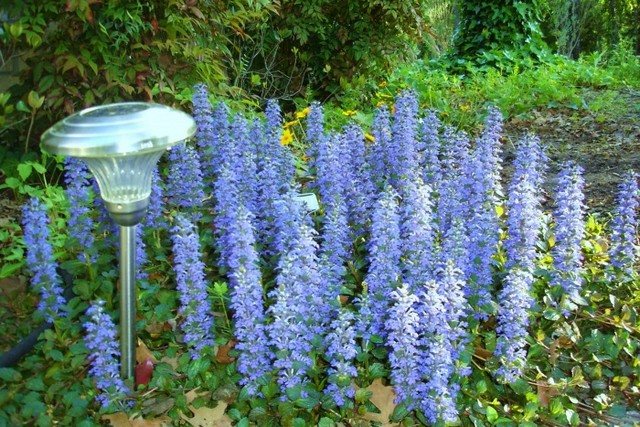

If you want to cover the ground with a carpet, you need to choose a variety of evergreen border flowers called tenacious. They are very unpretentious in care and tenacious. The plant has dark green leaves and beautiful blue flowers, collected in pyramidal inflorescences. The tenacious blooms at the same time as the irises, as well as the Japanese spray, so all three plants are perfectly combined with each other.
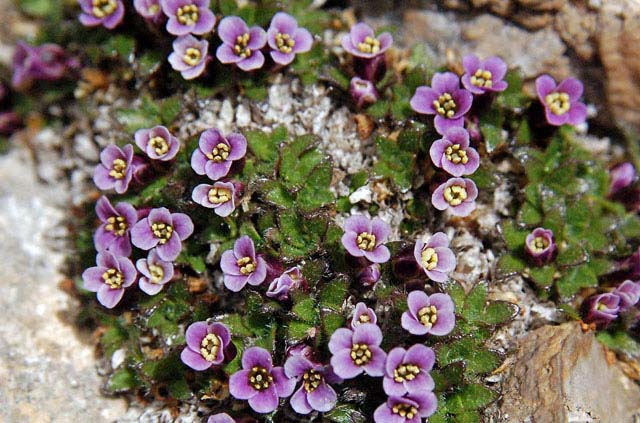

Inflorescences similar to field chamomile, but of a denser form, has maiden feverfew. These perennial low-growing flowers are propagated by seeds, first seedlings are nursed in greenhouses, then they dive and in June are planted in open ground. If these low-growing flowers are planted on the sunny side, the leaves will acquire a characteristic emerald green golden color.
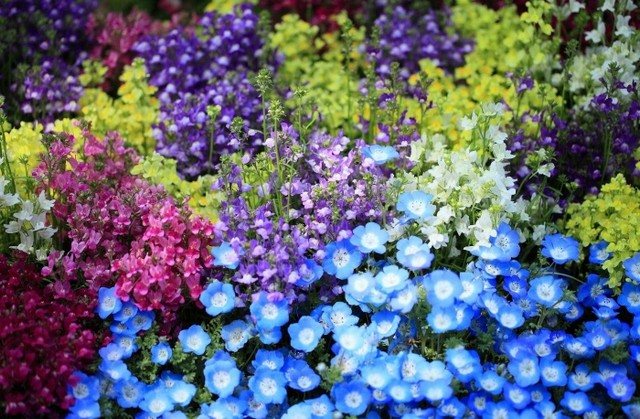

Nemophila bushes bloom beautifully - a low-growing plant with beautiful openwork inflorescences. Flowers bloom almost all summer, they allow you to form a fairly dense border. There is no need to cover the plants for the winter.
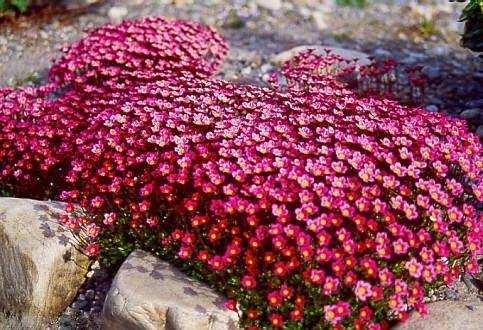

This is not a complete list of stunted perennials. It can be continued indefinitely. Therefore, Gertrude Jekkil has always created her flower arrangements, starting from a specific goal. She was very fond of taking Expressionist paintings as a basis and, looking at them, transferring the artist's idea from the canvas to the living lawn. The results were very beautiful.
Perennial shrubs for northern regions
Ornamental shrubs for Siberia
Flowering trees and ornamental shrubs for the garden
Bushes of hydrangea, mock orange, bladder, turf, cinquefoil, barberry, weigela and deytsii are the most popular ornamental shrubs for Siberia. Most crops are damaged at a certain level during the cold season.Low-hardy, but quickly recovering individuals (hydrangeas, spireas, mock-mushrooms) are suitable for successful planting in the fall. Winter-hardy varieties (bubbly, derain) also easily cope with autumn plantings. Budleya, calicant, cistus, karyopteris, holly, boxwood are the most popular perennials that grow successfully in the northern regions of the country.
Ornamental shrubs for the Urals
The longevity of decorative undersized and medium-sized shrubs for the Urals is ensured by a developed root system, early termination of nitrogen feeding, planting along vertical shelters from the wind, and thorough wrapping with agrofibre for the winter.
The rating of unpretentious shrubs for the northern regions is headed by:
- Honeysuckle (Latin name - Lonicera) is a curly odorous culture with paired white flowers.
- Juniper is the best specimen for lawn or path framing and goes well with a variety of horticultural crops.
- Rowan, creating an amazing symbiosis with fir and spruce.
- Dahurian rhododendron, which attracts the eye to the pink bloom in spring.
- Barberry Thunberg.
- Rosehip.
- Bush cinquefoil.
Under the cover of the mountainous reliefs of the middle Urals, the species listed above, as well as maiden grapes, frost-resistant sod, viburnum, spirea, and hawthorn are successfully developing. In the south, it is possible to breed a snowberry, chubushnik, forsythia.
Picturesque decor of the alley in the Urals
Important! Among the shrubs for planting in the Urals, the best choice will be old proven varieties bred in Russia and accustomed to winter frosts.
Flowering shrubs for the Urals
In the Urals, thermophilic perennial shrubs and shade-loving flowering plants are grown for summer cottages. The following crops are most unpretentious to severe weather conditions:
- budlei - shrubs 2-3 m high with pink, purple, white flowering;
- spirea - an unpretentious individual with airy-looking caps during flowering;
- calicant, which delights those around with water-lily flowers;
- evening primrose (shrub primrose) is the most hardy and unpretentious species in a family of 140 varieties;
- hibiscus is an ornamental shrub with bright large buds;
- crocuses - purple bulbous flowers;
- muscari, enlivening the borders with white, blue, purple pimples;
- creeping, erect varieties of shrub argiranthemum, impressive with a variety of blooms of yellow, white and pink shades;
- kalmia, similar to Chinese lanterns;
- weigela with juicy green leaves and white-pink buds;
- almonds are a light-loving plant that lives up to 130 years;
- jasmine is the owner of an alluring aroma.
Among the beautiful and unpretentious flowering shrubs, gardeners rely on cotoneaster, yellow jasmine and red barberry.
Types and styles of flower borders
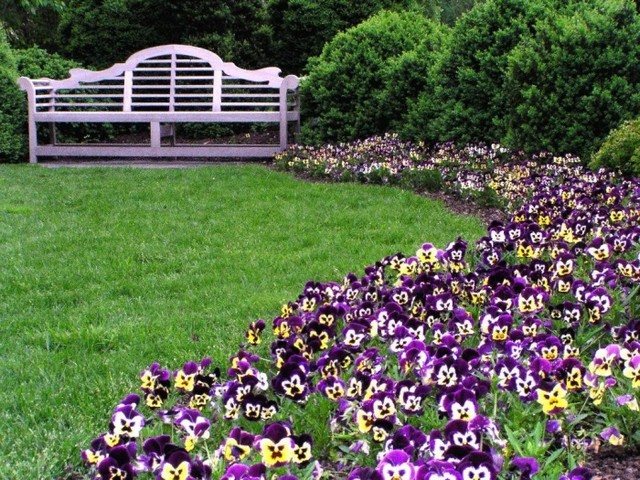

When choosing perennial flowers for planting, it is important to decide in advance on the type of flower borders, as well as the style of their design.
Similar garden elements are:
- Spring (borders will bloom only in spring)
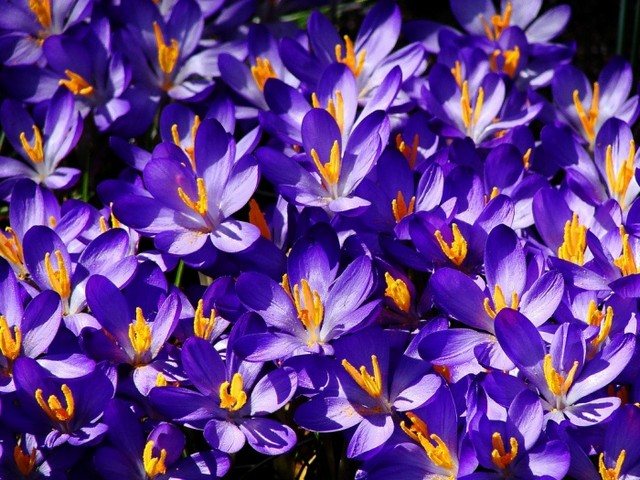

- Summer (accordingly, the edging of the flower bed will bloom only in summer).
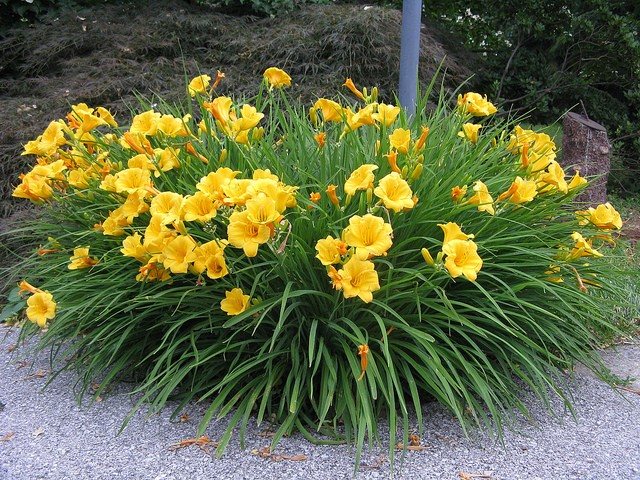

- Permanent (evergreens are planted for edging flower beds).
- Single row.
- Double row.
- Multi-row.
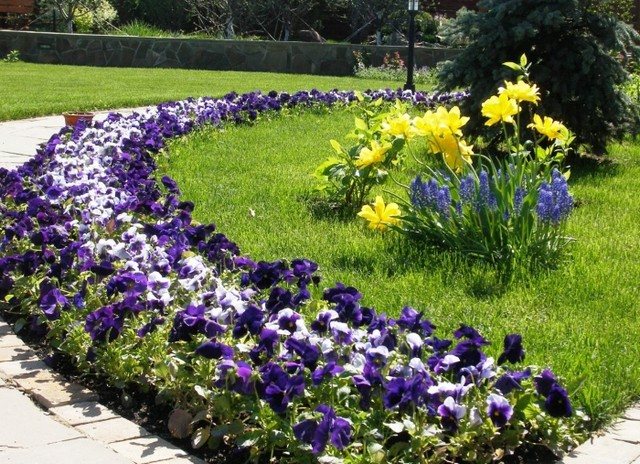

There are three styles of flower borders:
Rules for choosing perennials for the garden
Adding an article to a new collection
On the eve of the new season, flower growers are often in a hurry to acquire all the necessary ornamental plants as soon as possible. But in this matter it is extremely important to have patience, because not all flowers can be bought so early.
In early spring, you should not buy "cold-starting" perennials. They begin to vegetate at low temperatures and do not tolerate winter overexposure.
First of all, it is the favorite of the gardens - phlox... If the purchased rhizome of the plant is planted in a pot and placed on the windowsill, it will sprout, leaves will begin to grow. But this will continue until a certain time.Once the leaves will wither, and the plant will die, because no new suction roots have formed on the rhizome. Phlox will begin vegetation using its own internal reserves, without receiving any additional nutrition. It will turn out, he will eat himself! Therefore, phlox is best bought in the second half of summer. You can also blooming. Then they take root very well. Plus, you can see which variety you have purchased. The same recommendations apply to helenium, nivyanik, iris.
Care features
As a rule, perennial undersized flowers are easy to care for. Once a year, usually in spring, dried shoots are cut off from the plants, then all summer the flowers are simply watered, thinned out, weeds are removed. In the fall, when the green part withers, compost or fertilizer is introduced into the soil. If the flowerbed is settled in the sun, it is important to select light-loving flowers for planting, and vice versa, shade-loving plants should be planted in the shade.
A few notes on care
- Soil preparation. The absence of weeds and the fertility of the soil will ensure the good development of plants.
- Flowers are chosen depending on the position - for sunny, shaded, dry, humid places.
- Fertilizing and feeding. It is necessary to feed the plants, especially in poor soils.
- Filling empty spaces. Borders, in which "holes" have formed, look unsightly. It is necessary to plant fallen flowers and shrubs in time.
- Protecting frost-sensitive plants - shelter.
It is difficult to advise on the color and character of the borders. Some people like "rich" borders with several plants, others like uniform strokes. You can create one or more colored borders. It is important that the planting matches the character and style of the garden.
Perennial border flowers with description and photo
Border flowers are perennial undersized photos and the title is the topic of our today's article. IN landscape design flower border compositions are popular. You don't have to hire a designer to create combinations. Make a small project of the site on paper, mark the places where you want to plant border flowers.
With the help of such plants, you can make the zoning of the territory. Flowers between the recreation area and the walk-through yard will look good. You can decorate with a flowering border a playground for children, divide a garden with a vegetable garden, or highlight a flower garden.
Read also: List of gardening works, lunar sowing calendar for December 2019
What kind of border flowers are perennial undersized, see the photo and name below.
Ideas for decorating flower beds with stunted perennials
The most popular element of landscape design today is a rock garden. The composition is based on low perennials. These can be plants blooming all summer and ornamental-deciduous species. Most often, carnations, saxifrage, primroses, stonecrops and other low-growing plants are used to decorate a rock garden.
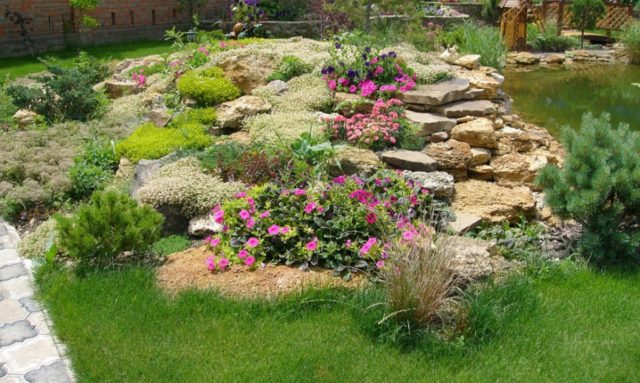

For a classic flower bed, low-growing perennials are combined with tall plants. The composition is supplemented with summer plants, spring bulbous crops. As a result, with proper distribution, the flower bed blooms all summer.
Low-growing perennials look good along the flower bed. They serve as a border and delineate the territory. Planting host, herbal carnations, stonecrop look beautiful.
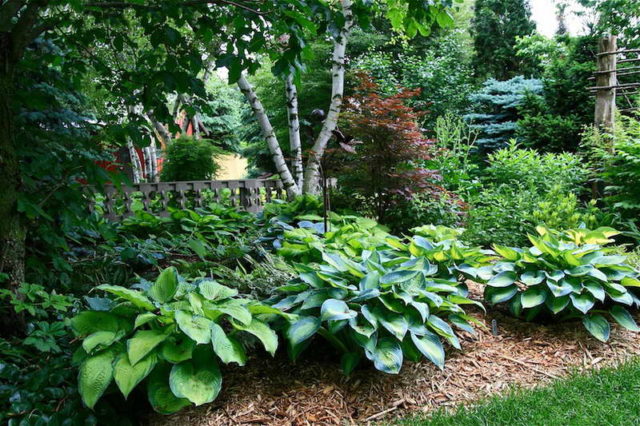

A fashionable trend in landscape design is the Moorish lawn, which consists of flowering low-growing perennials. These can be mono-plantings of one type or a combination of several.
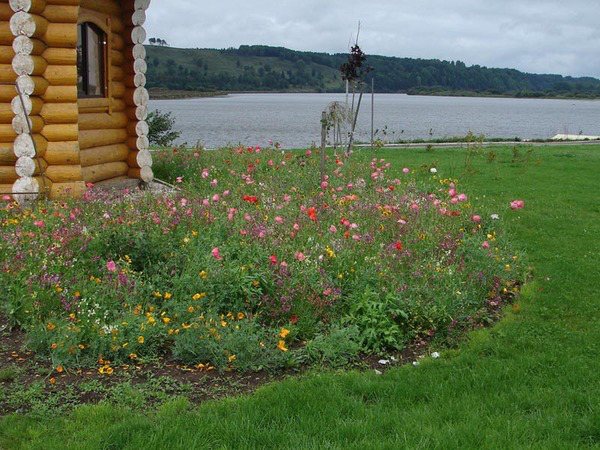

Border flowers perennial undersized photo and name
It is convenient to plant perennial flowers to create borders. Once, thoroughly deal with the design of the territory and then all that remains is to maintain the current form. What flowers are grown as a living border, we will consider further.
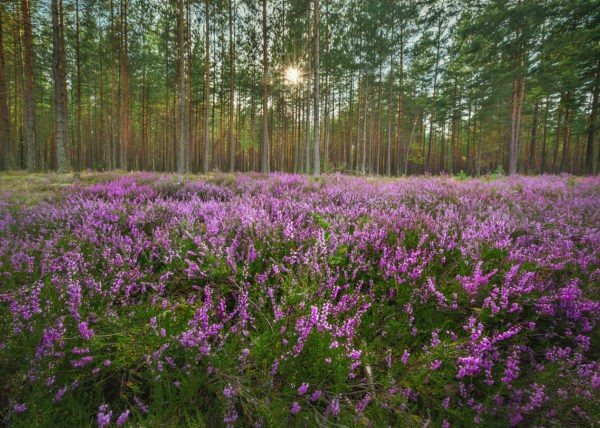

Heather plant unpretentious flower that grows even on acidic soil, poor in minerals.It can be compared to a weed, but Heather multiplies more slowly and blooms beautifully.
There are several varieties of the plant. Flowers can be selected according to the following parameters:
- the size of the plant, leaves, inflorescences;
- height of heather stems;
- shade of flowers;
- when the variety blooms.
Choosing varieties with different flowering periods, you will always have blooming, well-groomed borders. Despite the unpretentiousness of the culture, it is better to plant it in a sunny place. Heather does not really like shade, it will grow worse in a shaded place, and will lose its decorative effect.
Heather, planted along the paths in the garden, looks interesting. In this case, the paths are made of fine gravel. The root system of plants is protected from drying out, the gravel allows maintaining a sufficient level of moisture.
Alpine aster
Alpine aster another type of decorative border plant of short stature. The culture rarely grows more than 40 centimeters in length, the minimum size of the bushes is 10 centimeters. It blooms in small flowers, blue, purple, pink or white.
You will see the first flowers in June, the flowering period is up to 1.5 months. There are a lot of flowers, live borders look colorful and fresh. After a period of color, the plant does not lose its decorative effect. Dense, dark green leaves adorn the area until late autumn.
The plant does not require much attention to itself, it grows in any area. Avoid planting flowers in soil that has a large amount of moisture and a percentage of acidity. It is easy to propagate an aster by dividing a bush or growing from seeds.
The life of the plantings is 4 years, then you need to update the crops to preserve the decorative appearance.
A plant growing like a weed. Does not require attention to itself, multiplies quickly. The leaves of the flower have a dark green, almost purple hue. Zhyvuchka blooms in early summer, abundantly, for a long time. It grows on any type of land, looks interesting in combination with other flowers.
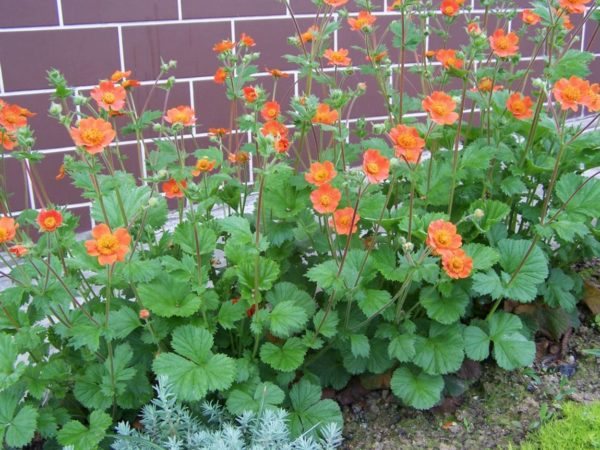

An ornamental border plant with bright, large flowers. It is considered a medicinal crop, is actively used in landscape design for zoning the territory, decorating flower beds.
The culture can multiply by dividing the bush or using seeds. The seeds of Gravilata are usually sown in the fall, after a few weeks the first shoots can be seen.
The plant does not die under the snow, and with the arrival of spring you will see a full-fledged culture.
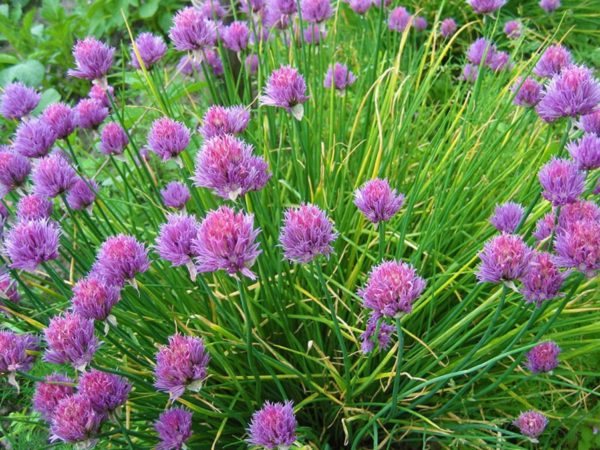

In appearance, the plant resembles an onion, blooms with small flowers of various shades. The culture is not demanding to the composition of the soil, it multiplies quickly.
If you plant a couple of rows of a flower, then the next season from each bulb you get a whole bunch of plants. It is used for combination with other decorative flowers, decoration of borders when zoning the territory.
The flower will attract bees to your site in the way it is considered to be honey. It blooms in small flowers, the shade of the inflorescences is pink, purple, white, purple or red.
It grows in small bushes, it looks interesting, both as an independent culture, and in combination with other flowers.
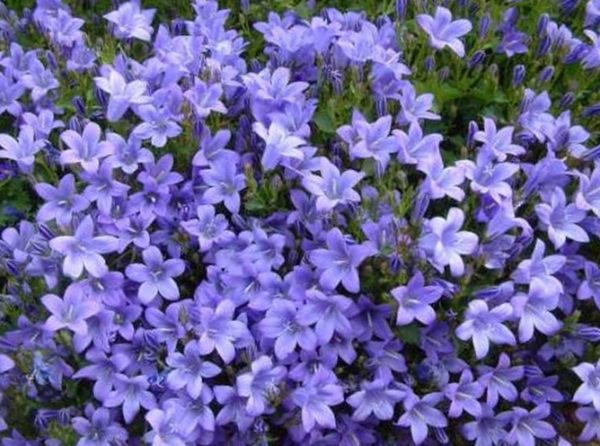

Plant periwinkle creep along the ground, has shoots 25 centimeters in size. It blooms in small blue flowers. There is not a single summer resident who has not seen the periwinkle with his own eyes.
The plant is best planted in fertile, moist soil and pay attention to the formation of bushes. Periwinkle can be planted as an independent plant or combined with other plants.
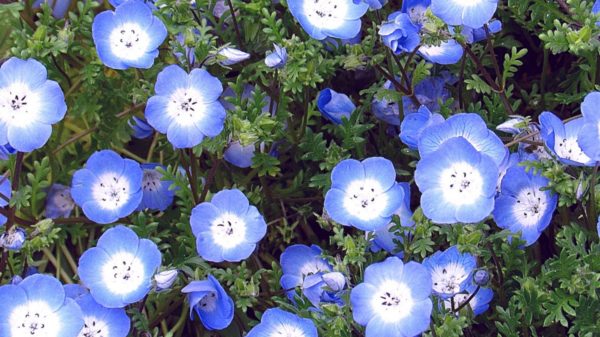

A low-growing plant, the maximum size of a bush is 25 centimeters. Possesses high decorativeness, leaves have a small edging. Flowering continues throughout the summer. Nemofila is used for independent decoration of borders, sometimes it is used to create flower arrangements.
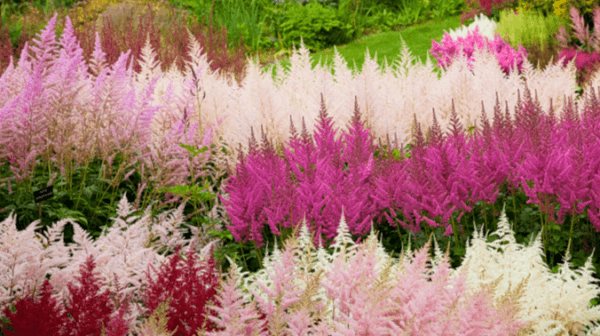

Astilba unpretentious frost-resistant plant. It blooms beautifully, rarely grows more than 25 centimeters.It normally tolerates winter with frosts, does not require additional shelter. It is recommended to pay special attention to watering these plants, Astilba loves moist soil.
The tint of colors can be purple, white, red, or blue. Can be combined with other perennial flowers for border decoration.
Rules for arranging curb hedges
To get a dense and dense living border, plants need to be planted in two or three rows. It will look neat if you keep it no more than 30 centimeters wide.
Before planting, the place for the future border must be cleared of weeds, loosened, and, if necessary, fertilized. Plants can be planted with seedlings, or you can sow a marked area.
If you know exactly what the composition of the soil is in your area, then in accordance with this, you can easily make a choice of suitable plants. For instance:
- On the loam, you can form a living border from the "Gnome" mock-up or "Dwarf" mock-up.
- If the soil is sandy and moist, then Japanese quince, beautiful quince, common heather, lingonberry will grow well on it.
- Sandy dry soils are preferred: alpine willow, steppe almond, steppe cherry, Bessey cherry, sandy cherry, caragana.
- Wet neutral soil is a reason to plant a live border of ferruginous cherries, “Dwarf” or “Dwarf” mock-mushrooms, holly mahonia.
- Undemanding to the soil composition: purple broom, birch meadowsweet, Bover meadowsweet, Thunberg barberry, Kuril Daurian tea, mountain pine.
Feel free to experiment on your site. Live borders will complement the beautiful picture of your garden, add their own flavor to it, surprise you with their magnificence. Your family and friends will surely appreciate the fruits of your labor.
The main thing is to pack well
But hosts they are not at all afraid that they will remain with an open root system for a while. Just slightly dampen the newspaper and wrap the plant's rhizome in it. Then wrap the "bag" in a plastic bag and put it in the fruit compartment of the refrigerator or in the cellar. These conditions are able to withstand daylilies, geychera, delphiniums, perennial asters, ferns, monards.
Sometimes in early spring plants with bare roots and overgrown leaves come to you. We'll have to occupy the home windowsills! Give the seedlings as much light as possible (but not the sun!), As little watering as possible (but without drying out!). And no dressing!
Annuals for borders
The border annual low-growing flowers shown in the photo are widespread in almost all regions. Plants resistant to bad weather conditions, easily recover from mechanical damage.
Eschsholzia
Border annuals are not afraid of drought, grow on any soil. Poor flower only tolerates an acidic environment. Seeds are sown in open ground in early spring, even in the snow, and mulch is poured on top. Ornamental culture reproduces well by self-sowing.
Purslane
The curb flower grows only 10 cm high. The plant forms a flowering carpet. Purslane in a flowerbed can be planted as an annual ground cover. The culture loves sun and sandy soil. Succulent leaves and stems help the flower survive in drought. Purslane is thermophilic. On the street, seeds are sown with the onset of stable heat. Seedlings are planted in early June. The annual reproduces well by self-seeding.
Calceolaria
Beautiful annual border flowers love light shade. The foliage is so delicate that it is afraid of water droplets. Watering is desirable at the root. There are indoor and outdoor varieties. The curb subspecies is grown by seedlings. Sowing is carried out from mid-February. Seedlings are planted outside at the end of May.
Balsam
Considering the photos and names of border annual flowers, one cannot overlook the plant, to which the people have assigned many different names. Culture is often referred to as touchy.The annual loves moisture and partial shade. Seeds for seedlings are sown in March. Sprouts tolerate picking normally. After disembarking on the street, the top of the plant is pinched.
Salvia
Most often, the border annual is found with red inflorescences, although there are also other colors. Flowers are popular for decorating park areas. Seeds are sown for seedlings from mid-February. Sprouts lend themselves to picking. Since the end of May, Salvia is planted on the street, a sunny site is chosen.
Lobelia
The curb plant can be grown as annual ground cover flowers that cover the ground with a thick carpet. According to the structure of the crown, it is a shrub or semi-shrub. Ornamental culture is considered perennial, but in our cold conditions only one season grows. Sowing for seedlings is carried out from the first days of February. The sprouts will appear in 2 months. Disembarkation on the street is done from the end of May.
Suitable plant varieties
Now let's take a look at the stunted perennial border flowers that will become a worthy decoration of your site. These plants allow the herbal part to die during the frost period, but retain the root system, which falls asleep until the end of the cold season. In early spring, such flowers awaken, new shoots and flowering appear.
One example of a plant with these properties is chives or skoroda. This flower belongs to bulbous plants. During the flowering period (late spring - early summer), a lush inflorescence of a delicate pink or purple hue appears at its top.
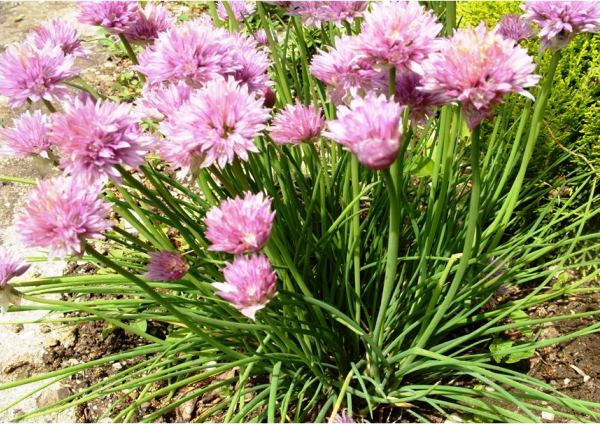

The next suitable variety is Arabis. This flower is melliferous and blooms in the form of snow-white, red, pink, lilac flowers during the flowering period (depending on the selected variety). They can be seen from May to June.
You can choose border flowers like gravilat. In addition to the beautiful flowering that comes in late spring, it is also characterized by medicinal properties. Gravilata flowers look like small open buds of orange, yellow, red or pink color.
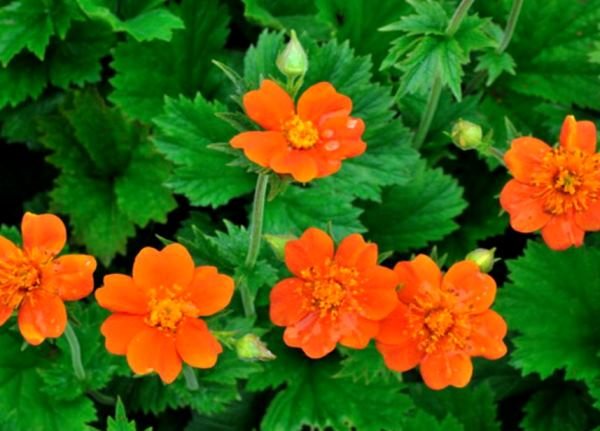

Stonecrops are popular in flower beds and gardens. These plants love light and are able to maintain their appearance and health only with a little shade.
But in the shade, the plant quickly fades and deteriorates, and can also change shape. Most varieties of this plant bloom in July and have the appearance of pinkish or yellow flowers.
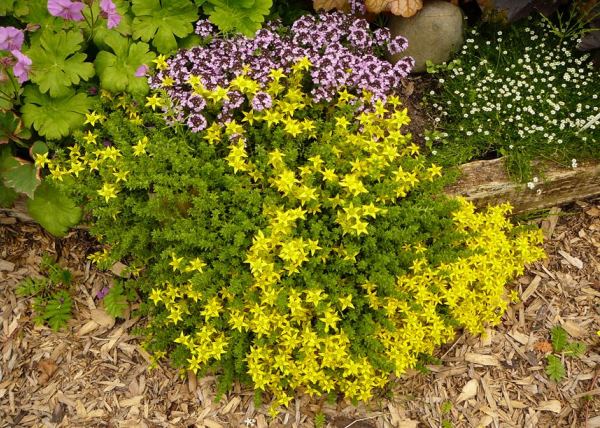

Unpretentious border perennials include tenaciousness. It covers the soil with a kind of carpet, is resistant to temperature, moisture and light. This plant can change its color depending on the season and climate.
The vertical blue inflorescences of the tenacious can be seen in May or summer.
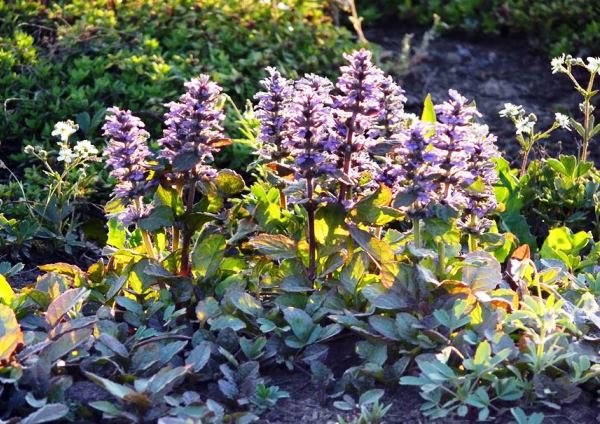

And if you like chamomile, then you will surely appreciate maiden feverfew, as it has a similar flowering in the summer. Refers to unpretentious and cold-resistant varieties.
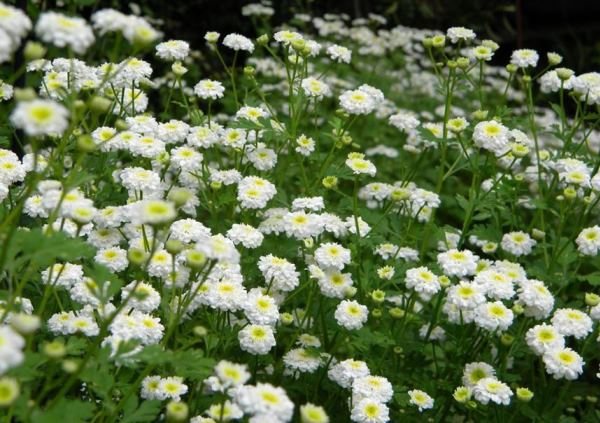

We also advise you to pay attention to perennial border shrubs, for example, Alpine aster, which can grow up to thirty centimeters. The flowers of this aster variety have a yellow core and pinkish or blue petals. It prefers bright areas or partial shade and blooms during June and July.
In winter, it is not necessary to cover such flowers, since they calmly endure the cold.
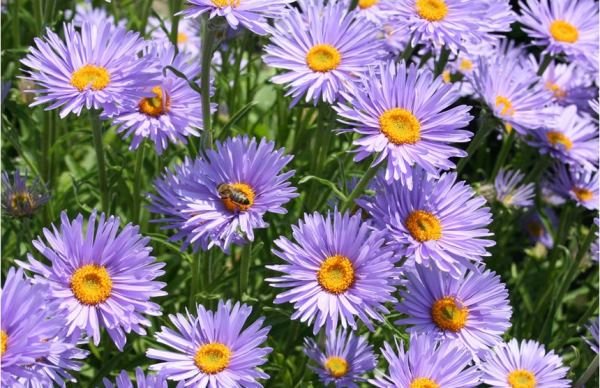

A long-term host is also suitable for decorating border zones. This plant is generally quite popular in landscape design, because even when it is not blooming, it attracts attention with its wide leaves of a dark and light green hue. And some host species also have bright foliage.
During the flowering period (from mid to late summer), inflorescences appear on the hosts in the form of brushes of snow-white, purple and bright pink shades. The stems are about thirty centimeters high.
Hosta has excellent frost resistance, but requires constant watering during high temperatures.
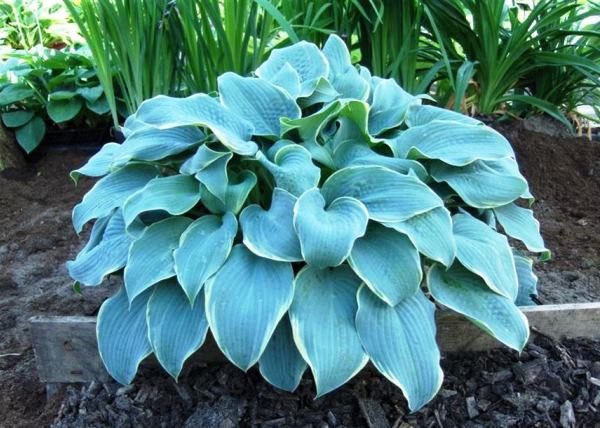

The border chrysanthemum has a small height (up to thirty centimeters).The flowers of this plant have different shades and bloom by the middle of summer. You will be able to enjoy the bright bloom of chrysanthemums before the frost arrives. Best of all, this variety manifests itself when planted in the sun.
Flower garden design recommendations
Thinking over the composition of your flower garden and options for using annuals and perennials as border flowers, consider the following rules:
- It is advisable that the borders contrast with the general flowers in the flower bed, so the whole flower garden will look bright and attractive.
- Keep in mind that perennial flowers will gradually grow, so when planting a border, give them more free space "for the future." To cover up temporarily empty areas, fill them with seedlings of stunted annuals.
- The classic width of the curb is 30-45 cm, and the height of the plants planted in this area is up to 40 cm.
When creating a flower garden with geometric shapes and lines from border flowers, select them in such a way that their decorative period coincides as much as possible and they delight you with their inflorescences at the same time.
Do not buy irises and peonies in spring
Irises both bearded and beardless do not like spring digging and transplanting. They can be bought in the spring only if the minimum time has passed from digging to transplanting. There should be no postage at this time. The same can be said about peonies... Of course, they will take root, but they will get sick, adapting to new conditions. The best time for digging, dividing and acquiring them is August, when the process of root formation is actively going on.
The specifics of gardening with annuals
Low garden annuals planted with seedlings allow you to create a magnificent flower bed in 2-3 weeks. These unpretentious annual flowers seem to be made for a summer residence. Low-growing plant forms will make your driveway look neat and tidy. Spectacular tall plants will already be located behind their colorful strip.
Low-growing annuals play a decisive role in landscaping due to their unique properties.
- Non-standard compositional drawing of a flower garden when using a different combination of colors;
- The onset of flowering in a relatively short time;
- The ability to create original ornamental flowering rugs;
- Long duration of flowering;
- A quick and wonderful way to fill the empty space between young perennials;
- Easy to care for.
Low annual flowers like to be planted along fences and paths, near walls and next to vegetable plants.
Principles for the selection of plants for a flower bed
It is necessary to select undersized annuals for a flower bed, relying on some of their general properties and the location of the future flower garden.
Beds of flowering low plants differ in characteristics:
- High level of sun illumination. Purslane, marigolds, nasturtium, geranium, calendula, seed dahlias, alyssum, petunias will bloom well here. Chlorophytum, ornamental cabbage, coleus, cinneraria will reveal the beauty of their bright leaves;
- The presence of penumbra. Such conditions like balsam, calceolaria, begonia, fuchsia;
- Humidity. Begonia, balsam, ornamental cabbage, coleus grow well;
- Color palette.
By the color of flowers or leaves of plants, they are guided by variegation, contrast or harmonious transitions. Low-growing white flowers will always be appropriate. There are many such annuals with different flower sizes.
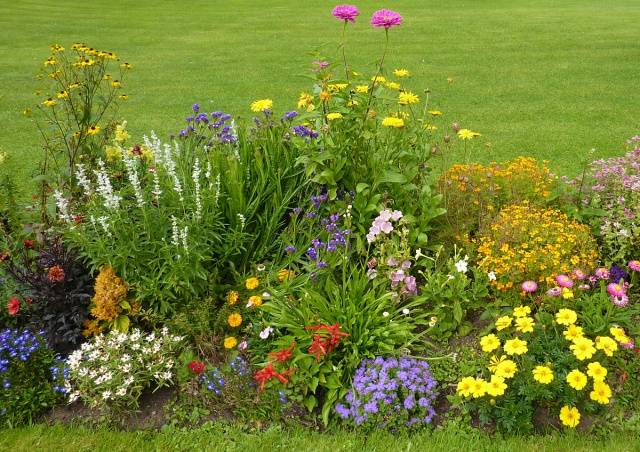

Curb plants
Annuals play a special role for the borders. They either contrast with the surrounding plants, or neutral colors - silver and white - prepare for the contemplation of a colorful show. Picking up flowering low-growing annuals, they are guided by the following rules:
- Continuity of the flower stream. It is necessary to sow or plant low annual flowers in two rows;
- The width of the borders does not exceed 0.5 m, plants are placed that is not higher than 40 cm;
- The constancy of the decorativeness of flowers, which does not depend on the weather. They plant hardy low curb annuals that do not suffer from rain or heat, but always remain presentable;
- Plant recovery. Curb annual flowers are at risk of being trampled or trampled by the mower. Fast regeneration of branches is a decisive moment in choosing plants for the curb;
- Good compatibility of undersized annual border flowers.
Appropriate care, regular watering and feeding will provide a border of low flowers or ornamental deciduous annual plants with a spectacular look from spring to autumn.
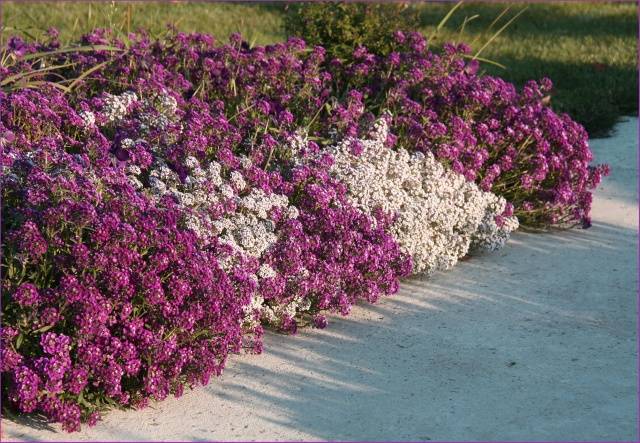

How to choose the right undersized annuals
Flowers love a large abundance of sunlight, therefore, flower beds of low-growing annuals are located in unshaded areas with moist soil. If the flower garden will consist of several varieties, it is worth considering a number of important factors:
- Low-growing flowers of different varieties are selected with identical requirements for growing conditions. This concept means the composition, nutritional value and moisture content of the soil, the degree of illumination of the flower bed.
- Combine annual crops in color groups. It is good when each variety stands out with contrast or the color of different inflorescences complements each other.
- Annuals are border, ground cover, undersized, medium, tall, weaving. They are placed on the flowerbed taking into account their growth so that the tall stems do not cover the small flowers.
When creating a composition of flower beds from annuals, the time of the beginning and end of flowering is additionally taken into account. For example, begonia blooms in spring, marigolds in summer, and asters from late summer or early autumn. When choosing a place for planting, take into account not only the illumination of the site and the type of soil. For each architectural structure, annuals are selected according to their height. In the front garden or near the garden paths, stunted and border flowers, for example, nasturtiums, are planted. It is optimal to arrange tall or climbing plants near the fence. Flowers in the form of petunia or sulfinia are suitable for pots.
Low-growing annuals for flower beds
Plants up to 30 cm high belong to the group of low-growing flowering annuals. Flowers are sometimes used as ground cover ornamental crops if it is required to fill the resulting void in the flower bed. Low-growing annuals look good between rose bushes or other ornamental shrubs. Flowers form a carpet in the meadow. A striking example of the undersized group is the night violet, Iberis. Daisies can be used instead of one-year-olds for edging curbs.
Curb annuals
An important role is assigned to undersized border annual flowers when creating a composition. Annuals are selected in contrast to the surrounding plants. If you plan to arrange a colorful flower garden, border flowers are chosen in white, light blue or silver. Neutral edging visually prepares vision for brighter colors.
Borders are equipped with a width of up to 50 cm. The border varieties include all annuals up to 40 cm high. Plants are characterized by resistance to heat and rain. Curb annuals recover quickly when trampled or mowed by the mower.
Groundcover annuals
The ground cover flowering annuals got the name because of their structure. Ornamental plants are covered with carpet on the ground. The inflorescences are usually small, but they often grow so many that you cannot see the foliage. Ground cover crops are planted in the garden, decorate an alpine slide, and are placed between stones. Small plots are allocated for annuals. They can fill voids in flower beds among other plants. Ground cover flowers are sometimes used as border crops to decorate the border.
In the video, a review of ground cover annuals:
Aubrieta
Aubriet is very popular among low-growing plants. Flowers bloom profusely from March to May. After flowering, they must be cut to allow for the re-blooming of the buds. The plant has many shades from pink to lilac. It reproduces well by self-seeding and grows rapidly.
A low-growing perennial hibernates with foliage. After wintering, the plant looks very attractive. Beautiful bushes delight the eye with their greenery. The plant retains its decorative properties after any frost.
Annuals
The life of an annual flower is short but incredibly vibrant. Before each season, I like to select seeds of their border varieties in the store, mentally creating a unique and harmonious composition of them. To make the flower garden look spectacular, it is important to use plants for it, the periods of decorativeness for which coincide as much as possible.
Despite the exotic origin of this annual, it feels good enough in the middle lane. Being a relative of the aster, the ageratum has a similar structure: small bushes branch strongly, and the flowering period lasts all summer.
Border varieties can have a variety of colors of inflorescences, and the leaves of the ageratum can be in the form of a rhombus, oval or triangle and have a dark green tint with spectacular light stripes. A plant with small flowers, collected in lush inflorescences, will certainly be a wonderful decoration for your flower bed or framing your path.
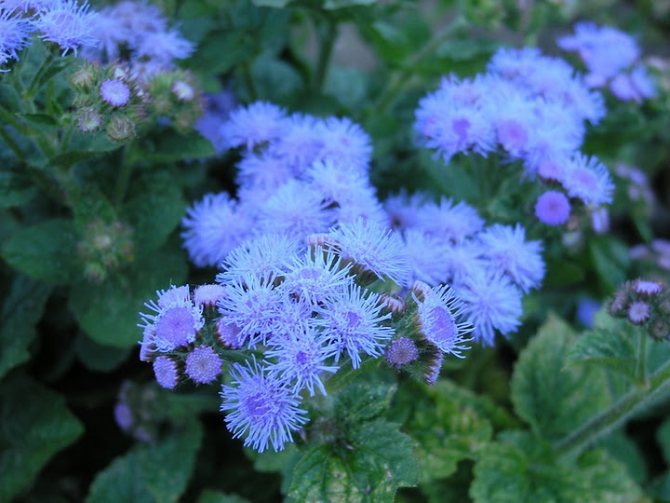

Another spectacular plant that can be a beautiful frame for your flower garden. Allisum belongs to the cabbage family, and today there are 200 of its species, most of which are stunted annuals.
Small flowers collected in a brush can have different colors, but the most popular among gardeners are white, purple, blue and red varieties.
Blooming allisum not only looks beautiful in a flower bed, it exudes a delicate aroma around it. Every year I try to plant this flower for seedlings, and for it has become one of the symbols of summer in the country. Delicate snow-white lace and the heady scent of allisum will certainly decorate your flower garden.
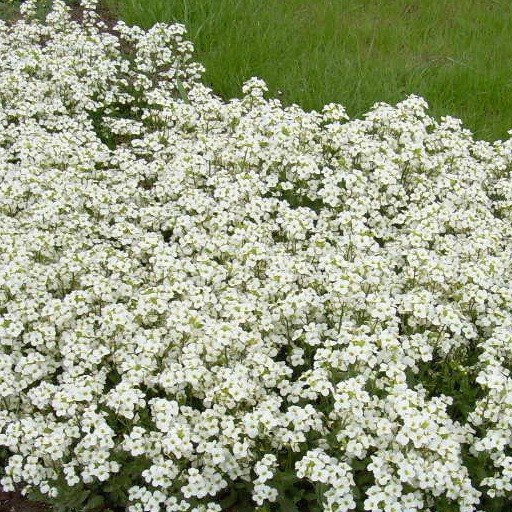

Hardy, reliable and bright - these are the qualities that marigolds are characterized by. Today, these annuals come in a ton of varieties with a variety of colors, so you can pick up a few undersized varieties to use as curb plants.
The height of low-growing marigolds varies from 20 to 30 cm. Plants begin to bloom a month after planting and retain their decorative effect until frost.
Another decorative representative of the cabbage family. Iberis varieties can have a height of 5 to 35 cm, and buds of complex composition can be colored white, pink or purple.
From seedlings of Iberis, you can create interesting geometric shapes on a flower bed, it will also look good as a border for a flower garden, an alpine slide or paths. The plant goes well with other curb low-growing flowers of warm shades.
Spectacular lobularia bushes give the flower beds a gentle airiness. A cloud of small inflorescences, collected in a brush, can be white, lilac or crimson.
The variety Lobularia Morskaya is especially popular with gardeners - it forms dense compact bushes that can be used to create geometric shapes, borders and edging on a flower garden.
Daisies
It is a very popular annual that is often planted by gardeners in flower beds. Delicate baskets of inflorescences look very impressive and cute at the same time. Bright daisies can serve as a frame, and also be planted in a dense group on a flower garden.
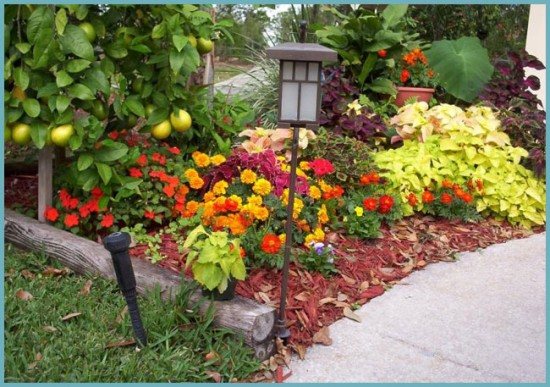

The plant can be perennial and annual, but gardeners often prefer to plant seedlings of the latest varieties.Low-growing variations of coreopsis can have a height of 8 to 20 cm; during the decorative period, the shoots end with spectacular baskets of warm shades.
Coreopsis looks especially beautiful as a border decoration of a flower garden with bells, chrysanthemums, balsam and dicendera growing on it. An annual flower will effectively complete the composition, adding a sense of warmth and tenderness to the overall impression.
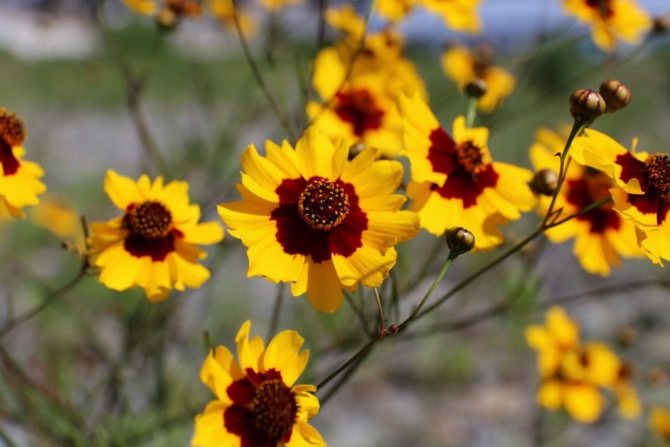

Another flower that is always popular with gardeners is nasturtium. Low-growing varieties grow into spectacular bushes up to 20 cm high, retaining their decorative effect until the first frost.
Annual nasturtium forms seeds as it blooms, which you can gradually harvest, store in a warm place, and use for planting next year.
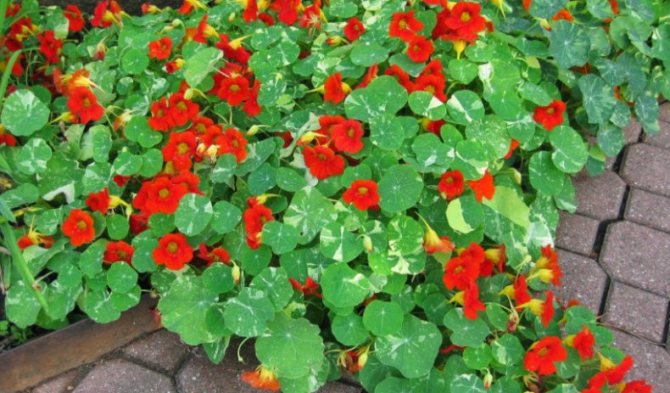

Chives
The names of the border flowers given in our article will help to orientate novice florists in the variety of perennials. Among the decorative forms, it is worth paying attention to the chives. The bulbous plant has a high reproduction rate. Just one onion, planted in spring, turns into a whole bunch by autumn. The plant is original. On the one hand, it has a decorative value, and on the other hand, it has food value. The culture adapts well to any habitat.
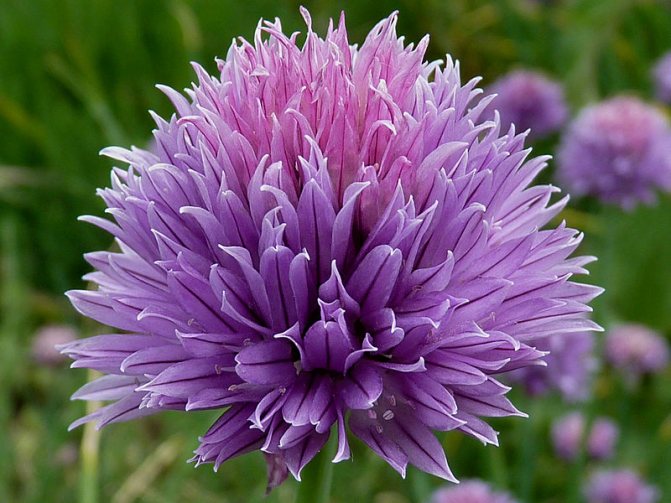

The plant does not require maintenance and is cold-resistant. Onions are propagated by seeds that can be sown in April. But it is worth remembering that the perennial loves watering. Otherwise, it loses its decorative effect. The rich shade gives the feathers good lighting. Otherwise, chives are not a hassle.
Features of the formation of flowering borders
Low-growing perennials will also be located at the middle level of the border area. Here you can also place plants with decorative foliage. But it is better to form the background of the border from higher plants, for example, undersized shrubs, blooming in a bright palette. Their height should be up to 0.4 meters.
Please note that the flowering vegetation that will decorate the border should have a harmonious color scheme. It is better to stick to one or two bright colors or contrasting shades.
Plant flowers closer to each other so as not to interrupt the color design.
Also, pay attention to some of the rules for decorating the border with flowers. For example, one should take into account not only the color scheme of plants, but also the palette of the border itself: these colors should not contradict each other.
When planting certain varieties, consider how much they will grow in the future. They may need more space to prevent the roots from damaging a nearby plant. Therefore, it will be better if you arrange the same type of flowers in a couple of rows.
Standard curbs are 0.5 meters wide and 0.4 meters high. But that doesn't mean you should go for a low floral frame. Focus on the place where it will be applied.
Some shrubs can be trimmed and shaped to create a harmonious and neat look for the curb. And in order for the formed design to last as long as possible, give preference to vegetation with a slow growth rate.
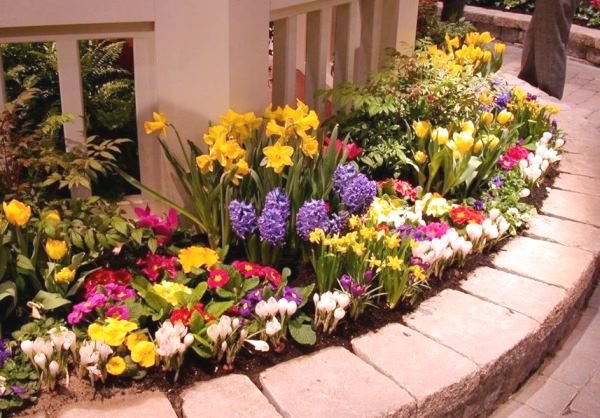

Since the appearance of some varieties can be affected by weather changes, it is better to give preference to plants that are unpretentious to wind and precipitation. Then you can be sure that the border area will look attractive in any weather.
When planning the device of a green hedge on the site, try using a brilliant cotoneaster: planting and caring for the shrub, the features of cuttings and the formation of the shape of the hedge by pruning are described in the article at the link.
Read about the main popular types of dwarf ornamental trees used in garden decor here.
For examples of beautiful Japanese stone gardens, see the article at: https://enn.imadeself.com/exterer/yaponskij-sad.html
Choosing a variety of low-growing perennial flower for the garden
When choosing perennial flowers for a summer cottage or suburban area, it is necessary to take into account the compatibility of plants intended for one flower bed or landscape composition.
Perennials must have the same requirements as:
- Watering frequency and method.
- Growth rate.
- The height of the bushes.
- Suitable soil composition.
- Fertilizers and the frequency of their application.
- The need and method of shelter for the winter.
- Love for the sun or shade.
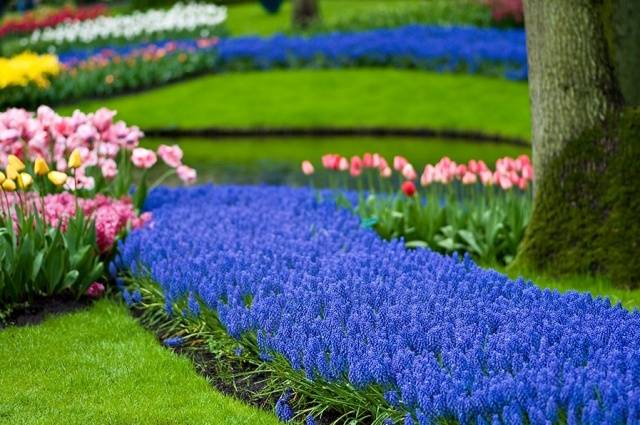

Astrantia is large
This undersized flower grows no higher than 70 cm. Sprawling bushes are covered with flowers at the beginning of summer, flowering ends by the end of August. In order for new inflorescences to constantly appear on the bushes, it is necessary to remove wilted flowers in time.
The shade of flowers of this perennial can be absolutely any - today there are many varieties of Astrantia, there are even bushes with multi-colored buds. But more often you can find a stunted perennial with flowers of white, pale pink or burgundy.
Planting a perennial plant is better in the sun, but a slightly shaded area, for example, a trellis shade from a gazebo or hedge, is also suitable. A low-growing plant is not pretentious to soil and care - Astrantia can grow anywhere.
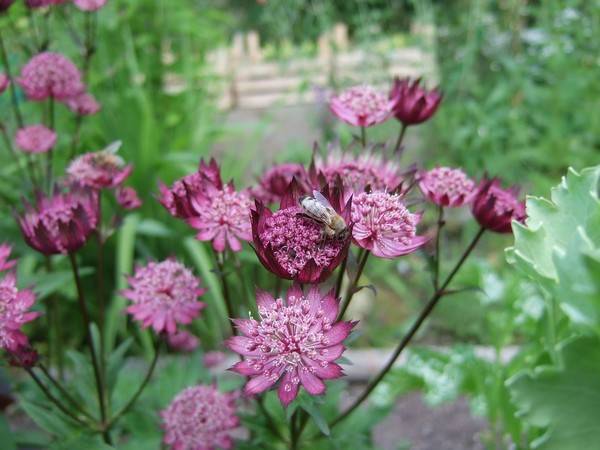

Oak sage
Sage (or salvia) also refers to undersized perennials that bloom throughout the summer. Bushes grow about 60-80 cm, sage is not sprawling, rather compact perennial.
The inflorescences of this perennial plant are very spectacular - long candles of a beautiful purple color. Sage should be planted in the shade, choosing areas with fertile and slightly moist soil.
Perennial is picky about care. It is very important to maintain constant soil moisture around the bush, loosen the soil in a timely manner, apply complex fertilizers, and protect against pests and weeds. But as a result of painstaking work, sage will reward not only beauty, but also health, because it is a well-known medicinal plant that saves from many ailments.
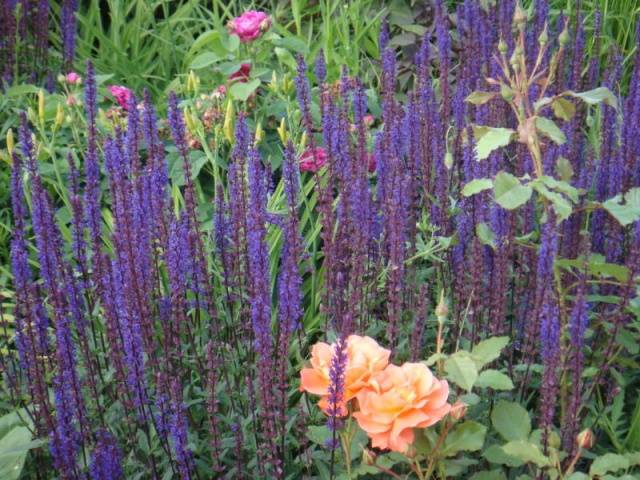

Armeria seaside
This perennial has about ten varieties, they all differ in appearance and characteristics. But, in principle, this plant is quite unpretentious. Armeria does not need to be watered often, any soil is suitable for the plant, even clay and sandy. Armeria will also successfully decorate rocky rockeries or rock gardens.
The flowering of this undersized perennial continues all summer long, and a photo of the bushes can be seen below.
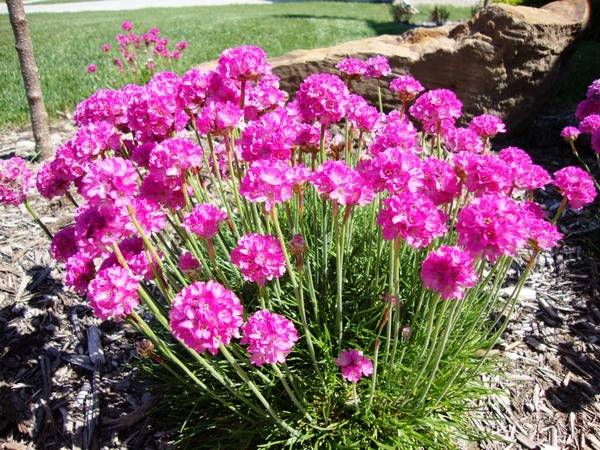

Alyssum Marine
Very tenacious and persistent perennial. The height of the bushes does not exceed 20 cm, strong stems literally crawl along the ground, decorating it with lush flowering.
Alyssum blooms for a very long time: the first inflorescences appear in May, and the last flower is able to withstand even slight frosts. In regions with mild winters, the perennial does not die off, but with the first rays of the spring sun it continues to grow and develop.
But even in cold climates, a perennial does not need shelter, the plant will firmly endure even severe frosts. The shade of the peduncles can be any: white, yellow, pink, purple.
Arenaria crimson
An ideal perennial for rockeries and alpine slides. This flower is so unpretentious that it can grow on sand or stones. The height of the stems does not exceed 15 cm, and the perennial shoots are colored crimson.
Curb rules
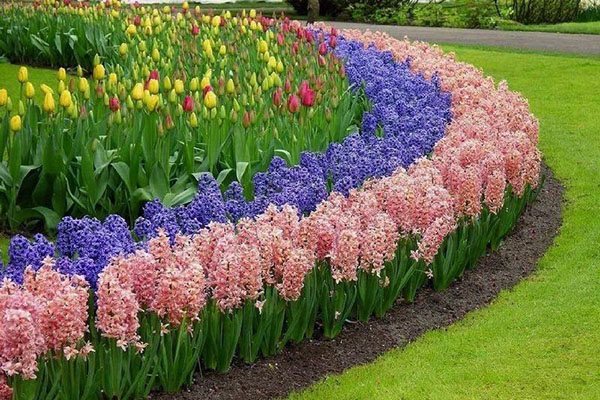

The border should be created from several types of plants so that it is pleasing to the eye throughout the summer.
Bulbous perennials bloom first in spring - it is better to plant them closer to the path:
Ground covers are also suitable - subulate phlox, herbal cloves, periwinkle, mint, basil, thyme.
This is followed by a strip of herbaceous plants that bloom in summer:
They will cover with their flowering mass the primroses that have departed by that time.
What can be used to make live borders - video
The roots of suitable perennials can withstand the cold in the ground, and the vegetative part awakens in the spring seasons.
Basically, border flowers are plants that are resistant to trampling and compaction of the soil. Perennials are preferable for breeding in a summer cottage, since they do not require mandatory planting in early spring, when the summer resident already has enough trouble.
There are quite a few plants with such features: let's look at some of the names and photos of perennial low-growing border flowers.


Border flowers, photo
Varieties of vegetation for curbs
Thinking over the appearance of the curb zone, immediately consider the possibility of dividing it into several decorative areas with their own characteristics. Between these areas it will be possible to lay paths or frames, as well as form ridges that look like a narrow strip of flower beds.
Low grasses and shrubs, which are perennials, are best suited for such purposes. They can be classified as groundcover or creeping, which will form a living carpet in the garden area, dwarf plants and low-growing crops.
Traditionally, the dividing strip is organized so that its width does not exceed fifty centimeters, and its height is forty.
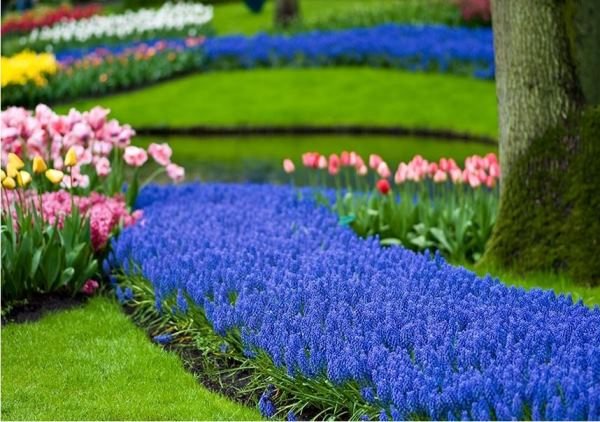

Often, garden paths decorated with borders are decorated with mixborders. They look like combinations of several varieties of vegetation at once, from grasses and small bushes to bulbous varieties.
An important criterion for the formation of such zones is the height of the plants. It will be better if the height of the flowers does not exceed twenty-five centimeters. Below we will tell you about which varieties and crops are suitable for these parameters.
But in the center of the flower bed it will be possible to plant flowers higher. They will become the main focus of the green zone and will attract maximum attention. Try to pick flowers that bloom at about the same time so that the garden area looks harmonious, and at certain times there are no empty zones on it that spoil the whole pattern.
See how you can equip a beautiful rockery with your own hands in the country: a photo with ideas and design options for plant and stone compositions in the garden and in the summer cottage.
Read about how to make a trellis for roses with your own hands in this article.
Give preference to container plants
Buy plants in containers, and you will have a 100% guarantee of survival rate, quality and no misgrading. In addition, there is no need to rush to plant - the plant can wait several days or even weeks! Maybe overwinter in the same pot. True, the assortment of plants in containers is not as large as we would like. They tend to be more expensive. And some of them, for example, geranium (varieties of blood-red geraniums), thyme, edelweisssome undersized sedums very poorly tolerated the cramped conditions of the potted keeping.
Carpathian bell
Carpathian bells are perennial flowers, the height of which reaches 40 centimeters. They can be planted in sunny areas or in partial shade. Bells bloom from June to October. They are very demanding on soil fertility. For good flowering, plants need a drained soil. Excessive waterlogging is detrimental to the culture. Therefore, it is very important to properly drain the soil, then the plant hibernates without problems. Watering the culture is necessary only during a long dry period.
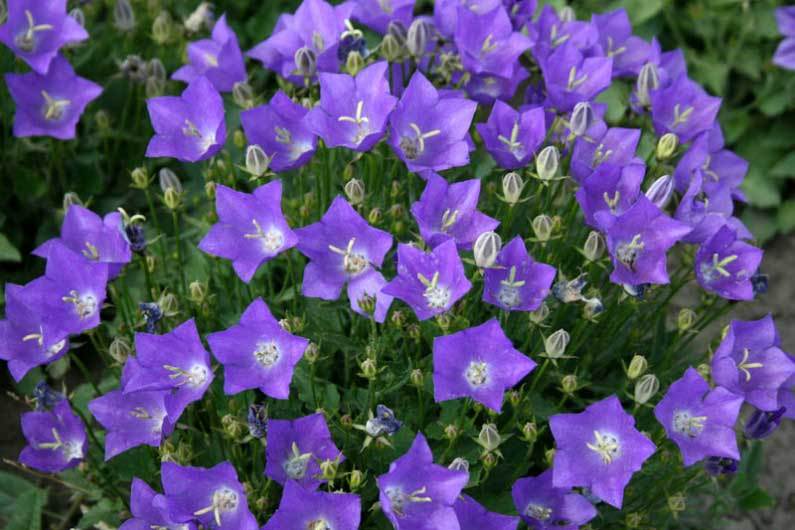

To prolong flowering, experts recommend regularly removing wilted buds. After wilting, the shoots are cut by a third. To obtain beautiful flowers in the spring, it is necessary to apply complex and nitrogen fertilizers. During the period of active development of buds, plants can be pampered with mineral subcrustations. For propagation of border perennials, cuttings and seeds are used.In the spring or fall, you can divide the bushes for further planting. Perennial is used not only for the design of full-fledged borders, but also for landscape design.

